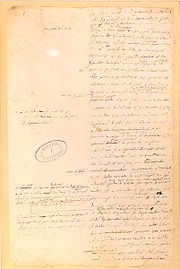Map of Amsterdam with numbered locations Short list of locations and subjects (dutch) List with more info (dutch)

'GOD IS THE ONE. HE IS IN ALL AND ALL IS IN HiM’
Ibn Esra (1089-1164)
SPINOZA’S SEAL
SPINOZA AND AMSTERDAM FRIENDCIRCLES
SHORT SUMMARY Spinoza and friends
JEWISH YOUTH
Spinoza is of maraans-sefardischJoodse origin. Neighbours are Franciscans. Already on his 24th year when done in the ban i by the (Sephardic) Jewish community (the reason is not entirely clear) he has non-Jewish friends, merchants that he will have met at the fair in the Nes/Rokint.
CIRCLES in which SPINOZA WAS IN AMSTERDAM
In AMSTERDAM Spinoza comes in different 'well-informed circles ', which partly overlap each other. Everyone seems to have had contact with Constantijn Huygens, father of Christiaan Huygens:
-the Flemisch Franciscus Van den Enden has until 1652 an art and book shop in the Nes. His brother has a art trade in Antwerp and gives graphic works. He has a Latin school on the Singel (~ Rhetoricsj and Theatre; ~ Plockhoy ~ Galenus Adriaansz de Haen; ~ Hartlib; delicious evenings with Spinoza, Burchard de Volder, Hudde, Lodewijk Meijer and Johannes Bouwmeester)
Publishers group-'In 't Martelaersboek '; Publisher Riewertsz (collegiant, Mennonite; publishes many books of collegiants); translator Glazemaker (~ mathematical Cardinael and first Neederduytsche Academy, Cardinael made son-in-law Glazemaker translator of Descartes after his death in 1650); printer Tymon Houthaak (~ Theatre via father); mercator sapiens and lender Jarig Jelles (lender for Spinoza's work; a Mennonite); Lodewijk Meijer (lexicographer; ~ Adriaan Koerbagh); Johannes Bouwmeester; Peter van Gent
-Ethics-Group: Simon Joosten de Vries, Louis Meijer, Johannes Bouwmeester, Pieter Adriaan Koerbagh Balling, and John ~ Amsterdam collegiants: below also hebraicus collegiantenvoorman Adam Boreel (~ Serrarius; ~ (forerunners of) Royal Society); Coen raat Van Beuningen, the diplomat (~ remonstrants); ~ collegiants outside Amsterdam-International circle freethinkers at the ' House with the heads ' of Louis and Laurens de Geer (~ Comenius; ~ Christopher Cunradus busier; ~ Oldenburg and Royal Society; ~ Menasse ben Israel)
-Johannes Hudde (~ Leids ' geometric company around Frans Van Schooten with Christiaan Huygens, Johan de Witt)
-rhetoricians-Theatre Group (~ Rozekruizers)
BOOK PUBLISHERS/PROTECTORS Spinoza's own mercator sapiens was friend's Jarig Jelles. Other patrons of interesting innovative work: Constantijn Huygens and Louis de Geer and Laurens; in England Boyle supports the release of work of Hugo Grotius.
WHAT LIVED IN THESE CIRCLES?
The advent of the later father of modern science Descartes brought on the Dutch universities a huge fuss. Descartes was protected by Constantijn Huygens, who put his attention on; also helped the visually minded Huygens Descartes enrich his work by means of images. Louis de Geer was also a protector of Descartes. Both patrons also have substantive reservations. As they realize like Voetius that the work by some thought would led to the denial of God leads (even though Descartes himself stays Catholic), where his dualism is easily to attack. Also they can not agree with his mechanistic worldview. Constantijn Huygens resolves this by the idea that there is a divine law-making architect.
Also Adam Boreel's international contacts asked him 'to be a defender against the calving of the piety and the atheism'. English pansofic circles as in certain circles of rhetorics were already accustomed to a very universal image of God associated with (al) Chemistry and astronomy/astrology; It was already going to see as part of a very large whole. There was interest and kinship with the thinking of the Rozekruizers. Some of them were scientists, whose theories are still valid today: Boyle and Newton. Cornelius Drebbel was his time with his discoveries forward. The philosopher's stone has been found in the element ' oxygen'.
Looking at Spinoza's environment, there is every reason to place Spinoza within the pansofic tradition: the Amsterdam collegiants, particularly Adam Boreel and their connections to the English (forerunners of the) Royal Society; the Rhetorics, artists and scientists (Dirck Volckertszoon Coornhert, Goltzius, Roemer Visscher, Cornelis Drebbel; see also G. Snoek: the Rosicrucians in Netherlands, mainly first half 17th century). Likewise another looked for the element that would make of iron gold, Spinoza was looking for the way to improve himself and all people through knowledge in order to achieve the highest possible happiness and love in accordance with the laws of nature. So would Rebirth can be achieved ('Short Treatise" and the TIE). The Rosicrucians-AMORC Web site states: "one can even say that the Rosicrucians-ideal is achieved in Spinoza. His Nicomachean stood above the differences of faith of Christians, Jews and Muslims. The seal of Spinoza is a rose. He wore this seal to a key, as a symbol of the access to the hidden truth '. Also a holy man in Spinoza Schleiermacher and others recognize imbued with a universal Holy Spirit.
'The goal is our nature, that we want to perfect to get to know as precisely as possible and of Nature as much as is necessary ' (Treatise for the improvement of the mind, TIE, 25). In the Ethica this line is more difficult to discern, because Spinoza aims especially at the cartesians, who are 'geometric'. He explains according to their own method and the idea that everything is composed of long chains of cause and effect, that a dualistic worldview is in inself in battle. In the letters he does this even clearer. Therefore he can draw the conclusion about what 'Slavery' is (Eth IV) and what leads to the Liberation (Eth V) at a high abstract and universally-applicable level.
SPINOZA, MATHEMATICS, HEBREW
it seems that Spinoza with his knowledge of Hebrew, mathematics and his universal theory, in which a God a place, which is not far from the already established idea that God also in ' the book of Nature ' (and in the laws of nature) had revealed at the right time in the right place and that the hopes on him was that he was Descartes ' work of his chilly mechanistic worldview could get rid without getting out of touch with the observed reality.
SPINOZA to RIJNSBURG, VOORBURG, THE HAGUE
Also which further points in the direction of Spinoza is known that well-educated circles much interest in him and his work exists and that he is the most influential people reached. It is unlikely that the Huygens family hardly paid attention to him would spend when he more or less next to them lives. Christiaan Huygens like Spinoza maintained contacts with the Royal Society. Christiaan Huygens takes the TPT thanks in reception. In the Hague would Abraham Cuffeler his best friend. This is akin to the family of super inventor and lenses grinder Cornelius Drebbel.
SPINOZA EN STAATSINRICHTING
Spinoza fits in his sociological work different scientific methods. Not only that of Descartes, which for the sociology of limited value, but also that of Frances Bacon. It leads to conclusions, which have found their way to the legislation in most Western countries. Themes include:
-separation of Church, State and science
-preference for Apostolic religion (religion with sample figures)
-freedom of thinking and speaking is not a threat to the State; the reverse is a threat
-space for own freedom of conscience alongside ' obedience ' to General appointments
-striving for power as much as possible (autonomy) in own hand; warning against abuse of power
SPINOZA REALIST
Like Rembrandt Spinoza belongs to the Dutch realism. The (inter-) human striving for self-preservation is on a subconscious level driven by a quest for "the highest good ', to that which gives peace of mind. This depends on conditions (time and place). A 'absolutely highest good ' is not to give: fulfilling the lesser ' good guys ' is conditional for the fulfilment of the highest. In the circles of Spinoza, for example in the case of Pieter Balling, consists the idea that eventually every man for themselves decides about this 'hierarchy of values', where knowledge can lead to the best choice. Although autonomy, freedom, justice and democracy high on the list are the sense of security and peace and to fulfill conditions have enough to eat.
WALK
The development in the archtictuur to the geometric shape is also in Spinoza's work to see: the former works (TIE, short Treatise and the TPT) are not in geometric (geometric) lines written like the Ethica. The development of the architecture is also in line with the three kensoorten: performances, ratio and intuitive sense (the third kensoort, connected to the human emotions and hence to the human ' happiness ') and ratio (the second kensoort, who want to exclude the emotions to get to know the laws of cause and effect).
Interesting locations are: synagogues Daniël Meijerplein, Mozes en Aäronkerk, Zwanenburgwal 15 (beeld), Nieuwe Zijds Kolk, Noordelijk grachtengebied (Westzijde), Keizersgracht 123, Bloemstraat 15-19 (Bibliotheca Philosophica Hermetica, entree 5 euro), Warmoesstraat 111, St Annenstraat 12, Gelderse kade 16
| NUMBERS | LOCATIONS SPINOZA | SUBJECTS |
| 15 | Zwanenburgwal 15, Waterlooplein 207 | Spinoza's place of birthk, statue |
| 8 *g, 13 |
Singel 425/UB, Waterlooplein 203 | Menasse ben Israel, Spinoza's youth |
| 4 | Nes 59 (nu Frascati) | Meeting friends, collegiants |
| 7, 24, 23 ** |
Spui/Singel 452 ('tLam), Singel 118 (de Zon), Singel 159 ('Bij den toren') | Mennonite parishes **g |
| 12 | Singel 267 (probably) |
Franciscus van den Enden, Latin school |
| 11. 31,38 |
Keizersgracht 384, Singel 140-142, Keizersgracht |
Theatre *∆, Spieghel*, Hooft |
| 16 | Singel 167 (P.C. Hooftgebouw) | NIL, café Stil Malta (L.Meijer) |
| 17 *gb/18 | Van Hasseltsteeg 54 and north near bij Nieuwedijk; Kolksteeg |
Rieuwertsz, tMartelaersboek |
| 21, 44, 47 |
Singel 284, Keizersgracht 50, Keizersgracht 123 |
Hudde *∆TT, Valckenier, De Geer * |
| 3 *∆ |
Stadhuis Dam, Nieuwe Kerk |
Koerbagh's condemned and buried |
| 19 | Bloemgracht, Rozengracht 184 |
Rembrandts atelier and residence after 1650 |
NOTES TO THE STATUE OF SPINOZA (Zwanenburgwal 15)
In the middle of contemporary life stands the statue of Spinoza on the Zwanenburgwal. Near his birth place in Amsterdam. In the picture are several elements of his theory.
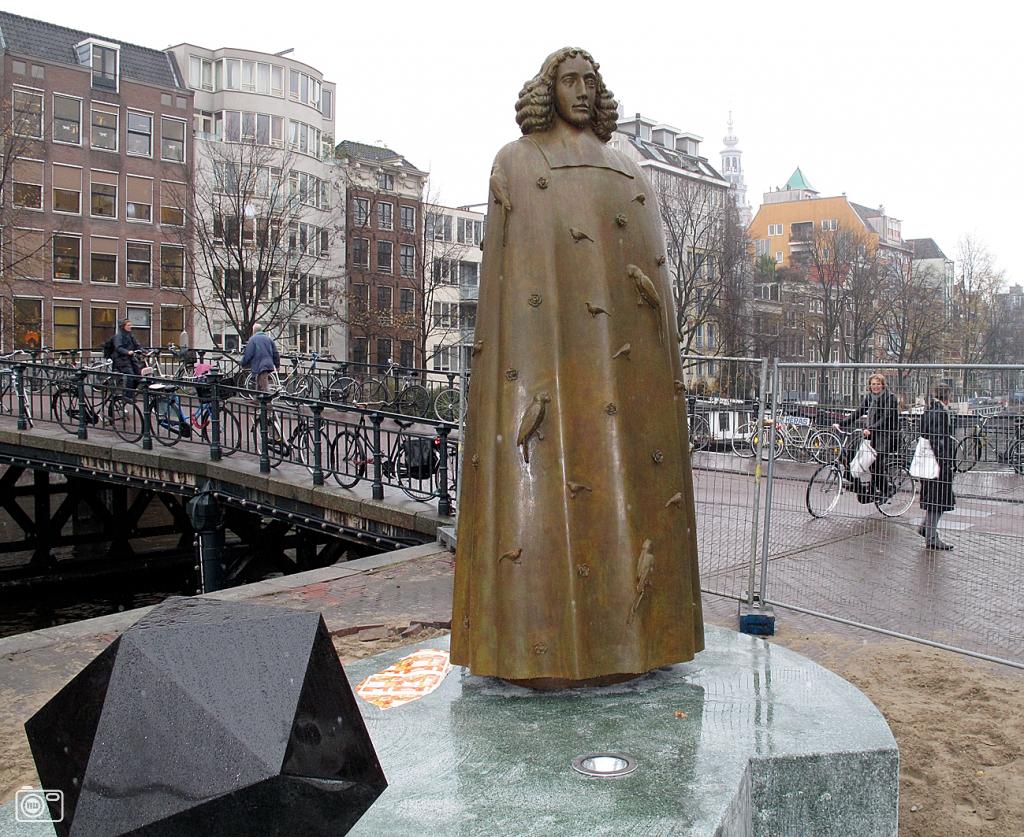
SPINOZASTATUE ZWANENBURGWAL
The statue by artist Nicolas Dings invites to sit on the spacious green-marble pedestal for a while. This has the form of an ellipse, which symbolizes infinity.
In addition to the statue on the robe with naturalistic symbols such as roses and birds-of-various kinds. The rose, which symbolizes love, combined with his name Espinoza (thorn). The thorn means: ' beware '. The birds of different feathers refer to people from many corners that were settled down in Amsterdam, such as the Portuguese-Jewish parents of Spinoza, and to the enrichment that the blending of their cultures with the Dutch Amsterdam brought.
In addition to the mathematical figure, the Icosahedron, a figure with 20 corners, a reference to the role of the mathematics and physics in his work. In the edge of the green marble, engraved ' the purpose of the State is freedom '. This refers to ' the goal of the State is peace or security "(Theological Political Treatise 5.2) together with ' the purpose of politics is in reality the freedom ' (TPT 20.6). Freedom has a broad meaning:
' ... that their minds and their bodies are safe and that they can develop their own forces and can use their minds free, and that they don't fight each other not by hatred, wrath or list nor mutually a hostile mind these bikes ' TPT 20.6.
SHORT LIVE-DESCRIPTION
AMSTERDAM
Spinoza, of Sephardic Jewish origin, maran of birth, was born in 1632 and came in the Nes as a merchant from his 17th year. That is from circa 1650. He meets than friends with who he maintains his life-long contact. After being expelled from the Sephardic Jewish community in its 24th year, he has had connections with friends and sympathisers outside the Jewish community. With his knowledge of Jewish philosophy, mathematics, the Bible and the Hebrew he gets an important input into the ongoing discourse in Amsterdam, although often in secret. In addition to the input of the Jewish education, a role plays that he quickly understands the work of Descartes, the founder of a new scholarly activities based on determinism, and even can form his own comment. A part of Descartes ' work is published in 1650 after his death. Spinoza comes quickly in contact with Descartes ' translator Glazemaker, which he probably advises and the Publisher of Descartes ' Jan Riewertsz, who also will edit part of Spinoza's work after his death. He opts for a life without wife and children and gambling on to become happy by the study of philosophy focused on (scientific) knowledge and achieving ' salvation ' from his way of virtuous life.
RIJNSBURG
On his 29th he moves to Rijnsburg (judging by the ' Correspondence ' he lives here already before August 1661). Here he sits nearer by a fuller, real university (Leiden) than Amsterdam University can offer him. Here he makes impression with his knowledge of and commentary on Descartes ' work, i.g. at the illustrious geometric company around mathematical Professor Frans Van Schooten. At the Rijnsburg cottage where he is residing stands a stanza of a poem of collegiant Dirck Camphuijsen (1586-1627).
Ah were all people wise
and wanted to do well
earth where a paradise
Now often is a hell
VOORBURG
After 3 years (spring 1663) he moves to Voorburg, where at least until september 1669 lives, resident in the house of a collegiant. Also the physicist Christiaan Huygens (belonging to Van Schootens society) lives here, with whom he maintains contact. He comes in Voorburg in conflict with the reformed pastors, what the reason is for a new book: the Theological Political Treatise (TPT). One of the reasons for the book is that he wants to show that he was no atheist. He did not succeed; the odium of atheisme, ' ongodisterij ', continues until long after his death (so far) around him. During the writing of the book change the political circumstances in the Netherlands change drastically. He may have wanted to play a role in the political situation which follows then and that might be the reason the book was edited without mention of his name in 1670.
The TPT contains ' Statements, showing that one can not only allow the freedom to philosophize with preservation of piety and of peace in the State, but also that they cannot lift her without peace in the State and even to lift her piety '. /From John, ho 4, v 13: ' we recognise that we Would remain in God and God in us, that he has given us of his spirit. "
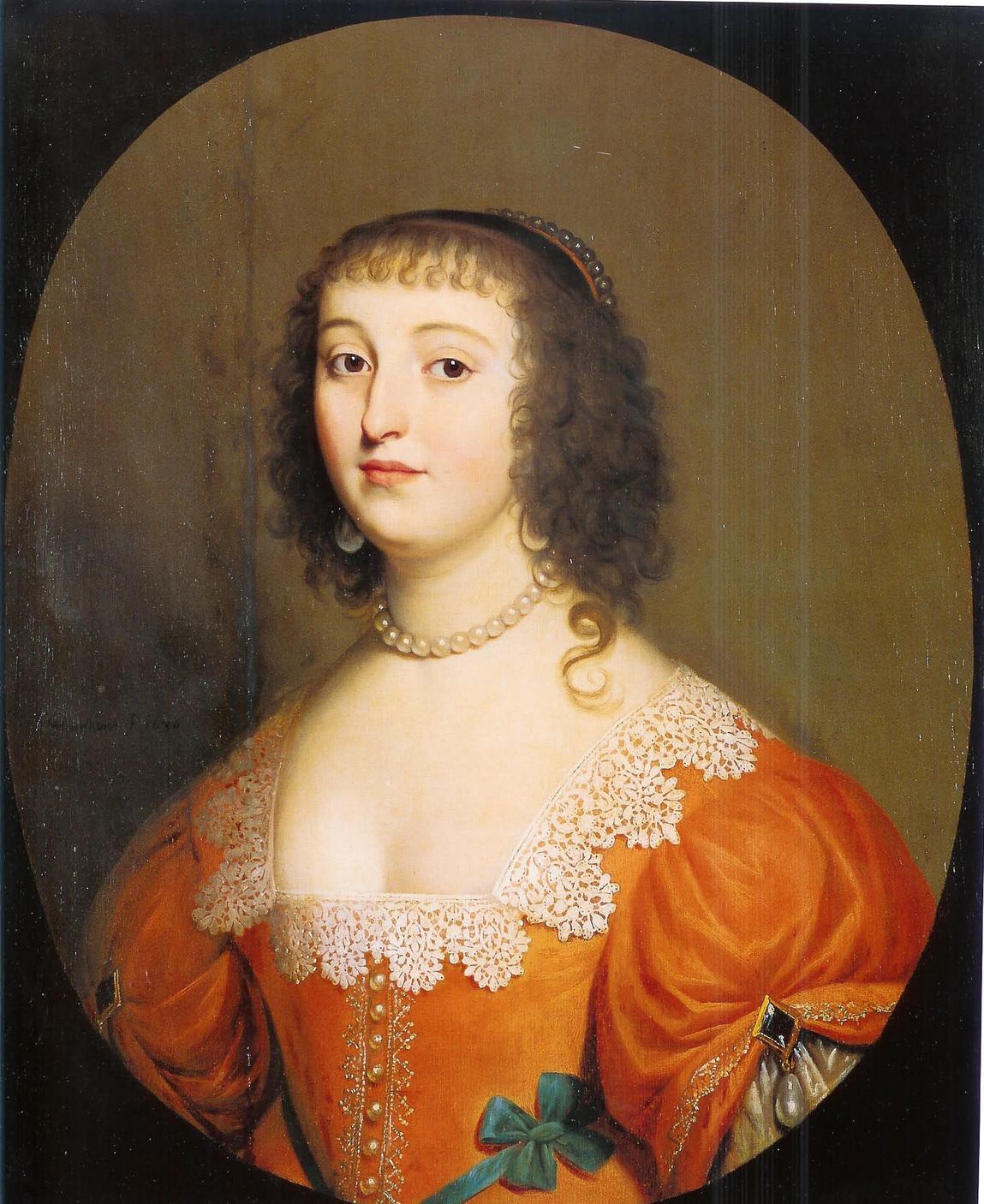 THE HAGUE
THE HAGUE
In 1669 he moves to the Veerkade in the Hague, where he comes into contact with international politics-progressive figures, for example the family Van der PALTS (see right ELISABETH VAN DER PALTS, 1618-1680) of the protestant union.
By her brother is Spinoza invited for a professorship in Heidelberg, what he skims over. In the Hague lives in that time also Spinoza's good friend Abraham Cuffeler (born 1637), in whose work many ideas of Spinoza appear in an easy understandable way (Klever, 1997, ho 8). 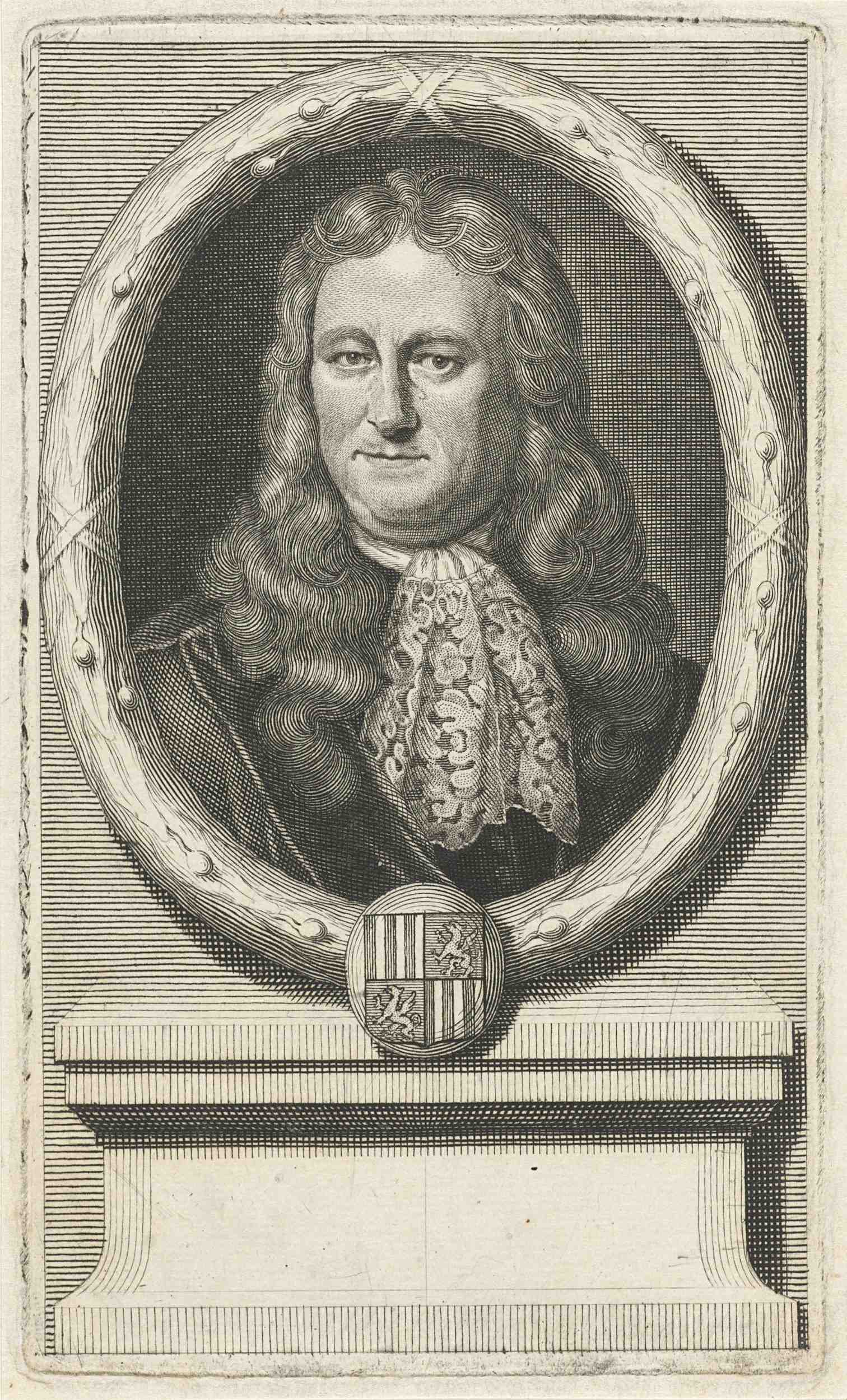
There are family ties with the inventor Cornelius Drebbel, of whom is known that he has affinity with the pansofy and he also writes a pansofic work himself, which is published at Riewertsz.
He has contact with philologists as Graevius and Isaac Vossius. As the famous rabbi Menassah ben Israel in 1657 dies, Spinoza with his knowledge of Hebrew, probably foolows him in of him translating and explaining Hebrew texts.
Spinoza may have yet a time believed in rebellion within France of the libertijnen, like Van den Ende. He visits in any case for unknown reasons (van den Enden?) in 1673 Utrecht to speak the libertine General Condé. In 1674 will his hope been bygone after the failed attempted coup and death of Van den Ende. In 1677 the Paviljoensgracht in the dwelling to Spinoza dies in the Hague. Apart from the publication of a textbook about Descartes under his own name and the TPT, his further work, including the Ethica, published after his death, without mention of author or Publisher by the Friends Group and publisher Jan Riewertsz.
PROFESSION AND LIVELIHOOD Spinoza comes from a wealthy merchant family, that also knew times of setback. Initially he is a merchant, but later he learns lenses grinding. This professionl, he will continue his life.
He has friends with whom he further develops his philosophy. Some of these often Baptist and sometimes rich friends offer to give him an allowance, what he ultimately accepts the required minimum. Spinoza's lifestyle reflects the 'ethics' of a financial enough. His simple and austere lifestyle is widely praised. For him is the most important thing that once his work is published. In the cost for that bears Birthday Jelles significantly. Jelles was a trader in figs and raisins but did in 1653 the case over to another and to dedicate himself fully to his rentenieren to study. The edition of the TPT is funded by Rieuwertsz.
15, 14. SPINOZA’s YOUTH (Zwanenburgwal 15 or Waterlooplein 207, then Houtgracht)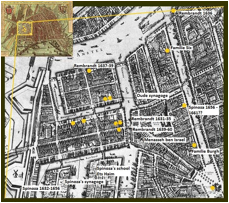
MAP OF SPINOZA'S BIRTH PLACE; BIRTHPLACE OF SPINOZA at the CURRENT STOPERA
If Spinoza was born at Zwanenburgwal 15, where now stands the image of Spinoza, or near the current synagogue on the houtgracht, is not entirely clear, but in any case somewhere on that square piece of ground, near the Stopera. An area where many Sephardic (Spanish-Portuguese) and asjkenasji (Eastern European) Jews lived.
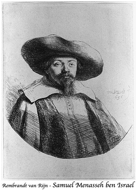 It is possible he was born next to the current Moses and Aäronkerk (where from 1640 a Franciscan community hosted). The Portuguese synagogue (Mr. Visser square 3) stood there in Spinoza's youth not yet. He has seen him after the opening in 1675 at a distance. The synagogue and schools that Spinoza visited, were on the Houtgracht Spinoza (now Waterloo Square). Spinoza has here a very good education with mathematics and music. He learned Hebrew and read the old testament.
It is possible he was born next to the current Moses and Aäronkerk (where from 1640 a Franciscan community hosted). The Portuguese synagogue (Mr. Visser square 3) stood there in Spinoza's youth not yet. He has seen him after the opening in 1675 at a distance. The synagogue and schools that Spinoza visited, were on the Houtgracht Spinoza (now Waterloo Square). Spinoza has here a very good education with mathematics and music. He learned Hebrew and read the old testament.
He was taught in Jewish philosophy by the rabbis Saul Levi Mortera (1590-1660) and MENASSE BEN ISRAEL (1604-1657) (right). This way he will have been familiar with the work of hit Maimonides (1135-1204), Gersonides (1288-1344), Abraham Ibn Esra (1092-1167) and Averroes (1126-1198). Menasse was one of his most liberal teachers. They lived in the same neighborhood. He was not only rabbi but also publisher of books (and stands for this reason in contact with the Hartlibians). He also has contact with collegiantenleidsman and hebraicus Adam Boreel, who lives in the Houtstraat. Boreel made in depth study of Judaism, with the ultimate goal the repent of Jews to the (Protestant) faith. In this he collaborated with Menasseh ben Israel and Judah Leon Templo. An important project was the translation of the Mishnah. On the Singel 425 is MENASSE BEN ISRAEL (right on an etching by Rembrandt) honored with a memorial stone on the wall.
During his early years Spinoza had been confronted with the humiliating rejection of Uriel da Costa (1585-1640) from the Jewish community. Spinoza's own ideas spurred like Uriel also not always with what he heard at school. This eventually led to his expulsion in 1656 from the possible Sephardic Jewish community, probably under pressure from the mainly Calvinist consistory, a depletion of the idea that there is no afterlife would be unacceptable found (statement of s. Nadler). What exactly caused the ban is not to say with certainty. There is still another explanation, in which a financial should be the motive plays. Spinoza himself has done no effort to undo the ban, something had was common.
4. NES: meeting with friends, COLLEGIANTS and FRANCISCUS VAN DEN ENDEN (Nes 59-65, Frascati) as merchant visited Spinoza the adjacent Fair regularly and he will surely near light-alcoholic beer have drunk, because the water was less appropriate to drink than beer. Spinoza is in any case actually signaled at café visit in the Nes witness a police report.
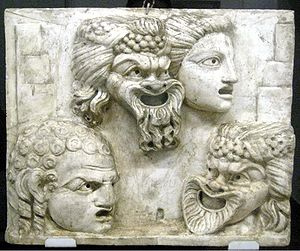
Probably Spinoza himself lived here too in this neighborhood in the period after his banishment from the Jewish synagogue in 1656. He met probably merchants, such as the Baptist Jarigr Jelles (1620-1683) and Pieter Balling, what became friends for life. Refugees from different countries often lived in these deep premises, which had been a century earlier monasteries with a tradition of receiving refugees. Below was also the FLEMISH FRANCISCUS VAN DEN ENDEN (1602-1674) with HIS ART-and BOOK SHOP (left) and a small printing company.
Spinoza will definitely have run by the shop, where was spoken about the contents of the books and so have come in contact with Van den Enden. The Flemish culture already had rather than the Dutch had a rich Renaissance development, which Franciscus van den Enden.
In Antwerp Franciscus had through his brother Martinus come in contact with the Flemish art world, including Rubens and Van Eyk (Rubens dedicates an engraving to Franciscus van den Enden). Probably Franciscus van den Enden starts a Dutch branch of his brothers trading on. In his house lived a pupil of Rembrandt, whio had a beautiful collection of prints of Lucas van Leyden.
With Jan Knol home in the Nes were collegiants-meetings. At such meetings was talked about religious doctrines and dogmas, as of the Fall and the existence of the afterlife. Or about the existence of witches. Here all denominations could speak. On some collegiants-meetings in the neighborhood (known is the Rokin), where Jan Knol or the Flemish Mennonite and socinian Galenus Abrahamsz de Haan (1622-1706) spoke, came a audience of 400 people.
A well-known collegiant with many international contacts was Adam Boreel (Middelburg, 1603-Amsterdam, 1665), a Dutch theologian and Hebrew scholar, perhaps also alchemist. Boreel was one of the founders of the College of Amsterdam collegiants. He was in contact with Oldenburg, Petrus Serrarius (this wrote about him with Boyle). They expected from him that he was a defender against atheism and the undermining of the piety under the influence of the ideas of Descartes. And with John Dury, Jan Amos Comenius and the 'Hartlibian ', the correspondents around Hartlib. He was also good friends with Menasse ben Israel. Riewertsz will in 1671 publish the work of Cornelis Moorman, a supporter and confidant.
7, 24, 23, 26. MENNONITE COMMUNITY 't LAM (Singel 452), de ZON (Herengracht 109-111; Singel 118), WATERLANDERS, BIJ DE TOREN (Singel 159) and Old MENNONITE CENTRE WATERLANDERS (Oude Nieuwstraat/Teerketelsteeg)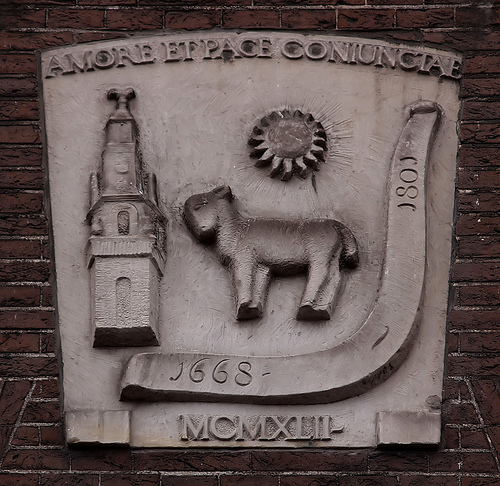 GABLE STONE tLAM
GABLE STONE tLAM
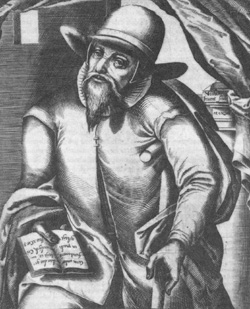
Many friends of Spinoza have a Mennonite or Mennonite background. Also his publisher Rieuwertsz and translator Jan Hendrik Glazemaker (1619-1682).
After the anabaptism in Munster on violent manner had tried to achieve their ideals, MENNO SIMONS (1496-1561) with (right) this flow in pacifist direction developed.
Core point of the Mennonite faith was the rebirth of the individual by God's grace, making these in his or her divine nature was restored. The born again person – the new creature-had the free will to resist sin and recovered using the ' Holy Spirit ' to complete and to become one with Christ. It is striking how much views (also in terms of ' morality ' money, see links) in the manual of the Baptist Christian ethics (Inleidinghe) directly from that era seem to refer to work of the always remained Catholic Dirck Volckertszoon Coornhert (Frijhoff; Spies).
There exists at the Anabaptists kinship with the Arminian, remonstrant movement. And with the choice of van Oldenbarneveldt for peace at the 12-year-old file. Usually life the Mennonites relatively sober in the spirit of Coornherts ' Comedy of the Rijckman '. That among the Anabaptists many influential and wealthy merchants were, showed the exhibition ' 450 years Mennonites in Netherlands '. The Anabaptists wore circa 1672 by a significant loan to the fight against the French. A ruling of Riewertsz about Jelles, both from Mennonite circle, shows their respective ideas. Jelles emerges as a ' mercator sapiens ', a merchant, who with his wealth wants to contribute to knowledge and science.
RIEWERTSZ ABOUT JELLES: … … but seeing that the tendency to accumulate money and goods could make him happy in the soul, he has his company, when that very well ran and a lot of money, to a fair Manager left and loosened himself of it. Without ever getting married, he has looked up to the outside melee to the world's silence to concentrate on knowledge of the truth, which leads to God's salvation, and thus to obtain the wisdom ...
Jarig Jelles grew up on the Damrak, near the current Victoria hotel. His father had a stone facade on the House with the imagination of ' Hope '. This is part of ' faith, hope (' The hope remains our geduurig require ') and love '. He has a House on Herengracht 109. Spinoza's friend Simon Joosten de Vries (died 1667) lived on the Singel 112 ' The Vriesche Boer (Farmer) ' .
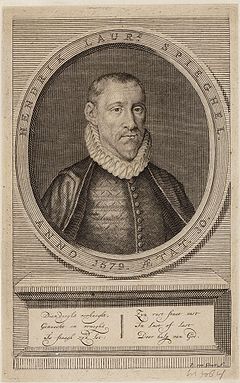
11, 16, 19, 21, 23, 34 , 28. SCHOUWBURG (Keizersgracht 384) and his history; NIL's CAFé STIL MALTA (Singel 167); REMBRANDT (Rozengracht 184; Bloemgracht); BIJ DE TOREN (Waterlanders, Singel 159); Lodewijk Meijer lived in his youth in the Dolle Begijnsteeg, corner Oude Zijds Voorburgwal 92 (naast 'De Bulldog'); Vondel lived in his youth Warmoesstraat 39, later Spuistraat 188.
About "The history of the theatre" is written by J.A. Worp. Members of the rhetoric chambers gradually went to the direction of the Singel, such as H.L. SPIEGHEL (right) and the Keizersgracht (P.C. Hooft). Aan de Keizersgracht settled previously (1618) the first Nederduytsche Academy (which the father-in-law of Glazemaker belonged, the mathematician Cardinael. The man through whom Glazemaker became the translator of Descartes ' work), who had quickly to withdraw in order of the 'Vroedschap'. More about this branch of d'Egelantier with motto ' Zeal ' on the left page (under ' politics and rhetoricsj ' and ' Stage performances on the street ').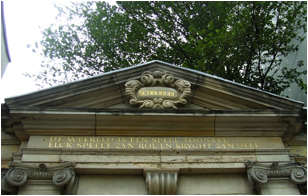
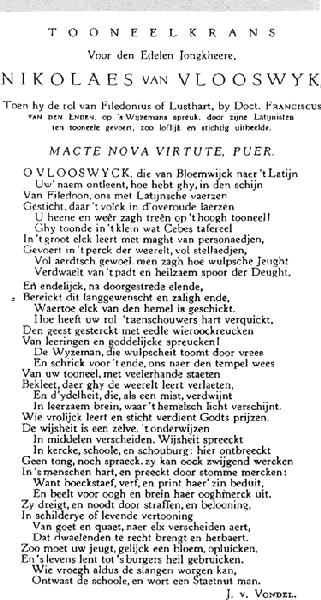
ENTRANCE THEATRE
The performances in the Nes moved to the theatre on the Keizersgracht, 1637 by van Jacob van Campen was built. A statue in the square behind the gate honors Coster, Vondel and Hooft as founders of the Dutch stage. Above the entrance Vondels's words: ' De weereld is a children's Theatre, Elck plays his role and gets his part '.
The theatre had a function in showingf the ' roles ', in which one could recognize themselves. Through the scene the audience could be called upon to an ' inspired and wise ' life. Could also through on-the-classics-based performances indirect criticism be expressed on political figures.
Classical plays of the Roman Terentius (-195 to-159) by Franciscus van den Enden as teaching materials were used. Passages in Spinoza's Ethica came out, probably because Spinoza also appeared in such a piece (as a slave in Eunuchus). In 1657 a play by Franciscus of the Enden themselves, Philedonius, ' Lust heart ', was performed; a piece about controlling lust by reason. Joost van Vondel wrote ' TOONEELKRANS ' for the protagonist (right)
LOUIS MEIJER and NIL The Schouwburg of van Campen is rebuilt In 1665. The rebuilt Theatre has other possibilities. There can be used more technique and stunts are performed. This is a new orientation of the Baroque theatre to performances in: on ' rational-classical ' bedrock Theatre according to the ideas of NIL. The from home Lutheran Louis Meyer (1629-1681) is from 1665-1669 have been Director of the theatre, but get the occasional disagreement with Spanish repertoire ' and the leidingover ' NIL in 1669.
Classic plays of the Roman Terentius (-195 to-159) by Franciscus van den Enden were used as teaching materials , namely Meijer follows a second line namely that of the first Nederduytsche Academy to make Sciences accessible to everyone by making the scientific terms to translated from the Latin in the Dutch, inspired by the ideal of his purist half-brother Kók, who has become a known-lexicon writer. Standardization and definition plays an important role. The idea is that it saves time, when people need to learn to not Latin still take knowledge of scientific results.
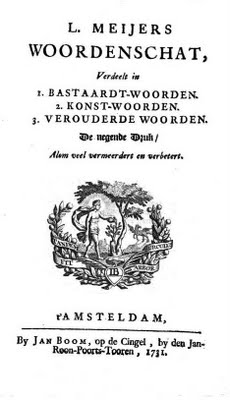
The company NIL played several works of P.C. Hooft again. There was also a ' modern ' implementation of Gijsbrecht van Amstel of Vondel: all prayers and long-winded passages were deleted from it. The Gijsbrecht was a tribute to Hugo de Groot, who lived in France in 1638 as balling.
Meijer has written two works, from which his approach suggests: 1. a lexicon with a classification of words in: bastard words and art words and 2. ' In the tooneelpoëzie Naauwkeurig onderwys ' (published in 1765). This last is an attempt to stage laws; entirely on ' rationalist ' basis. It also gives a description of the affections derived from Spinoza. Somewhat ' mathematically ' intent with many definitions and precise distinctions. He aims to draw up a play theory according to a scientific approach.
With the lexicon he makes the work of his brother. A first version of the lexicon is published by Boom, a next part by Rieuwertsz.
Johannes Bouwmeester, best friend of Louis Meijer and member of NIL, confidant of Franciscus Van den Ende, brings in 1672 at the Hayy ibn Riewertsz translation of Tufayl's ' Yagzan ', possibly at the instigation of the circle around De Geer and the Hartlib circle around of the Royal Society.
Pococke, belonging to the De Geer-circle was already in the thirties working on the work. It emphasizes that people even without geometric knowledge can get ' true knowledge "can get from experience. The book ' The life of Hayy ibn Yagzan ' gives in a simple way partly Spinoza's thinking, including the geometric method in very understandable language. This fits well in the pursuit of accessibility of knowledge for everyone, also one of Meijers ideals. It has a slant based on empiricism, which is also in Spinoza's work is to be found. It seems to be an example of someone, who became wise, without scientific knowledge. Spinoza answered builders question ' how te get wise? ' with a reference to the emirische method of Bacon combined with a steadfast character.
Not everyone can like Rembrandt, Vondel and everyone in the vicinity of Spinoza can fully support rhe new the new Descartes-rate. So Serrarius has criticism. However, the theatre pieces in the spirit of NIL from 1679 (the theatre has to close the doors by of the Vroedschap during the war years 1672 to 1678 ) stepped up and pulled a small century long good audience. They are pieces that on simple way put an ' uplifting ' morality without reference to God on the shelves. Probably here is a historical connection to the influential 't Nut van het Algemeen', whose Baptist founder Jan Nieuwenhuijsen (1724-1806) had in 1787 the Headquarters in the 'Sun'/Singel.
13. THE LATIN SCHOOL OF VAN DEN ENDEN, STAGE. Science, politics (Singel presumably 267)
In 1652 is Latin SCHOOL of Franciscus Van den Enden (1602-1674) bankrupt and he is forced to log on to the ' Boedelskamer ' in the Desolate City Hall, where bankruptcies are handled. He moved with his family to the Singel, where he founds a Latin school. The most likely is that he and his first wife Clara Maria and children coming from Poland on the Singel 267. He would then have come to live in a building of the Haarlem poets family of Elslant. Boëthius of Elslant is mentioned by Maria Tesselschade Roemer.
Several future poets follow classes at this school: Elslandt, Joannes Antonides van der Goes, Jan van (1647-1684), Pieter Rixtel and Nicolaes van Vlooswijk.
Spinoza will learn Latin in this school and also give lessons himself. Probably he also lived in the House of Franciscus van den Enden on the Singel in consideration that he gave lessons. On the Latin school learned Spinoza not only Latin. Here was also a lot of talk about theatre, science and politics. The school performed (classicist) pieces in Latin in the theatre.
TONEEL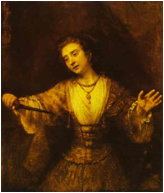
Classic plays were used by van den Enden as teaching materials. Emotions (see rule of LUCRETIA, painted by Rembrandt), which play such an important role (Ethica III) in Spinoza's work is , are well bid.
SCIENTISTS
Van den Enden is a versatile person, who among other things made detailed study of the newer philosophy, such as Frances of Bacon, Descartes and Hobbes (' Rather ... ', pg 32). Some of the students at the Latin school turn out to be future scientists. Van den Enden and especially Spinoza gradually comes in contact with the scientific world. Spinoza in particular also by his knowledge of Hebrew and innovative ideas of the work of Descartes. How Spinoza exactly came into contact with Descartes ' work is not known, but it is obvious that booktraders like Van den Enden and Rieuwertsz played a role and have been for Spinoza on interlocutors.
Van den Enden, Spinoza, Burchard de Volder, (1643-1709), (from 1670 Professor of experimental physics in Leiden), Johannes Hudde, who lives on the other side, Louis Meijer, Johannes Bouwmeester meet regularly in ' delicious 'meetings, according to P. Baert in a letter to Christiaan Huygens (Klever 1997, p 206). The Danish anatomist Olaus Borch (1626-1690) writes about Amsterdam that this had become a meeting point for radical and atheist Cartesians. And mentions that the City Government had forbidden van den Enden public action. In 1662, it was Van den Enden forbidden to discuss in public, because "his conversation showed characteristics of atheism '.
VAN DEN ENDEN and POLITICS
He fulfilled in addition international diplomatic functions. He would have had a share in the realization of the peace of Münster (1648). He also wrote proposals for egalitarian settlers-communities. There were settlers who settled in the new, often quite empty, areas that were captured in other parts of the world. He was actively involved in the foundation of a ' new ' community in Delaware by P.C. Plockhoy (Zierikzee, 1625-Delaware, 1670), see also j. Lindeboom ' Stepchildren of Christianity '. Who was friends with Galenus Adriaansz de Haen, like him, came from Zeeland. This stood for separation of Church and State, a 6-hour working day and democracy and was in contact with Samuel Hartlib. The latter was also in contact with the circle of Louis de Geer to the Keizersgracht 123. The methodologist of the later Royal Society, Francis Bacon, is already turning to find similar ideas about ' new land'kolonieën ', such as New Foundland.
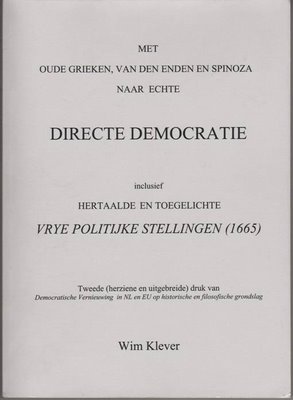
In his ' Short of New Nederlants Verhael Gelegenheit ' (1662) van den Enden gives his views on the political concept of ' equality'. The State should bring benefit to everyone in equal measure. The wellfare-highering effect of the State must occur independently of one's talents, sex, property, and social status. He opposes expressly that equality would mean assimilation.
The laws should focus on the public good while they give space for individuality to everyone in an equal way .
In his (left) ' VRYE POLITIEKE STELLINGEN' (1665), van den Enden ' 'pioneer of democratic thought', speaks for freedom of speech and for the common law to develop. Further, he works out the idea of folk-sovereignty. He is convinced that the people through experiencing the practice of democracy in public meetings and consultations will win insight.
As an example of how democracy can work he calls the State of affairs in Holland during the eighty years ' war against Spain. But he also warns that all officials with a watchful eye should be followed, especially those who Excel in eloquence and greed. In the PostScript he speaks his anger on Hollands laxity in this time of war, which he on the Regents says that it ' the only congestion are of the Dutch people brave zeal '. Van den Enden speaks explicitly about the blockade by the English fleet and on the recent intake of New Netherlands by the English.
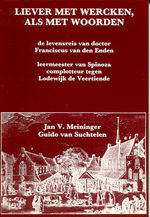
Van den Enden is considered (Wim Klever) as a forerunner of the French Revolution, where the concepts of freedom, equality and fraternity to measure were of a new society.
Francis will be hung in 1674 the Enden on the Place de la Bastille because a planned coup together with rebellious nobles against French SUN-king Louis XIV was untimely discovered. It seems likely that this coup he has been prepared in advance for a number of years. Van den Enden lives than a few years in Paris as personal physician of Louis XIV. It is not known how long he already was busy with the preparations. The question is the extent to which Spinoza has been aware of this (see "TPT"). In any case, son-in-law Kerckring (1683-1693), who like van den Enden was active internationally and diplomatically, seems also to have been involved (alleging ' RATHER WERCKEN.... ', right). The hasty mariage between Theodor Kerckring and Maria Clara Van den Enden just before Van den Enden's departure to France, seems to have had a political goal (also). There is a possible relationship with the visit of Cosimo III. In any case will Theodor have later still contact with the Grand Duke and Niels Stensen and the Grand Duke financially supports Maria Clara, after contact with Theodoor is finished.
47, 35. LOUIS AND LAURENS DE GEER (Keizersgraht 123), SERRARIUS and the Rozekruizers (Bloemstraat 16; Bloemgracht 19), Oldenburg, LOCKE; 47, 48, 49; COMENIUS
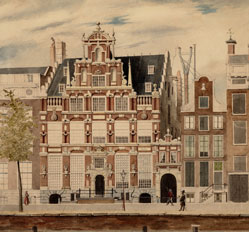 The family de Geer is one of the richest in the Republic. Thanks to the lighter, more easily transportable artillery that the Dutchman of Walloon descent De Geer produced, Sweden became an important military power . He brought the Walloon blast to Sweden and pulled from 1620 to 1640 thousands of Walloon and Lorrain workmen.
The family de Geer is one of the richest in the Republic. Thanks to the lighter, more easily transportable artillery that the Dutchman of Walloon descent De Geer produced, Sweden became an important military power . He brought the Walloon blast to Sweden and pulled from 1620 to 1640 thousands of Walloon and Lorrain workmen.
The House was a hospitable meeting point of freethinkers who found a safe haven in Amsterdam. Both father Louis (1587-1652) as son Laurens de Geer (1622-1666) supported study and publication of dissident writers and philosophers (such as René Descartes, Jan Amos Comenius and John Dury), also of writers from previous centuries, including
Rosicrucarians and freemasons, and realized in their home a versatile library..
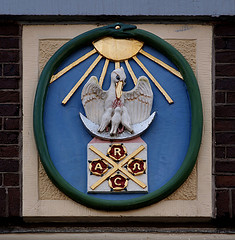
Works now for a part are found in the Ritman collection in the Bibliotheca Philosophica Hermetica, for which the Christian-hermetic gnosis forms the central unifying element (right EMBLEM BPH).
The word "Hermetica ' refers to the Egyptian man of wisdom Hermes Trismegistus. Among oyher things he develops alchemy. On the one hand, there is a chemist side: focused on chemical transformation processes. On the other hand, a psychic side: focused on the possibility of human transformation and achieve greater human happiness.
The search for the ' stone of the wise men ', the world soul, will eventually lead to the designation of ' oxygen ' as the stone. Also searching for the making of gold and the interest in Kabbalah have to be seen in this light. Physical-scientific findings, which have been confirmed by modern science as ' true ' insights like those of Boyle and Newton, tribe also from this tradition of the search for universal knowledge.
Downstairs one finds in the main showcase the Opera Posthuma by Spinoza; on the first floor including the ' Wercken (complete works) ' of Dirck Volckertszoon Coornhert. Several works are printed in Amsterdam. Publishers include Johannes Janssonius and Christopher Cunradus.
Comenius is in contact with Petrus Serrarius (1600-1669), Dutch theologian, millenarian, merchant and collegiant. He is of Scottish descent and has studied in Oxford. This is considered the ' Dean ' of the dissidenters in Amsterdam. He has contact with Adam Boreel (1603-1667), John Dury (1596-1680) and Menasseh ben Israel (1604-1657) (Richard Popkin: Spinoza and the sciences, 1986). Also with quakers, and William Ames (English protestant, who interfered in the controverse between Calvinists and Arminians; 1576-1633). 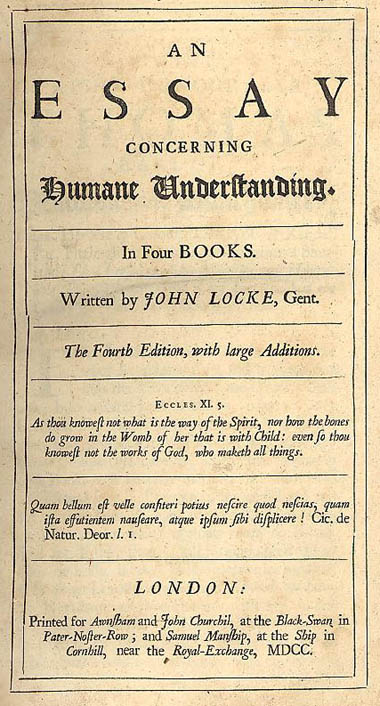 According to Popkin, there exists a close association with Spinoza, whose protector and contact with the outside world he would be.
According to Popkin, there exists a close association with Spinoza, whose protector and contact with the outside world he would be.
In these circles lives a high future expectation, widely shared. Serrarius comes several times with a different year for the arrival of the new Messiah (1656, 1665). This also has international-political sides: Menasse ben Israel tries to move England to admit Jews. Spinoza also seems certain to 1658 to be interested in these ideas together with two Jewish friends Juan del Prado and Daniel Ribera. Spinoza's contact with Oldenburg (brother-in-law of John Dury) is here probably arise. The originating from Bremen Oldenburg (1618-1677), Secretary of the English Royal Society, maintains contacts with European
scientists and has contact with Robert Boyle (1627-1691) and Thomas Hobbes (1588-1679). 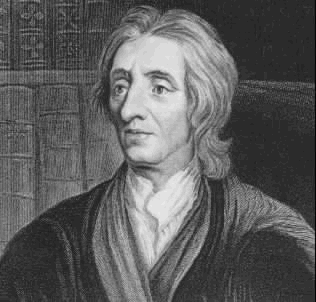 He corresponds also with Spinoza. Robert Boyle finances Edition of books in English in London (of Grotius ' De veritate religionis christianae ') according to Klever he discusses the letters in small circle, including Boyle and John Locke (1632-1704). Klever is convinced that especially the later as Lighting philosopher known Locke enthusiastic about Spinoza's work. He shows that LOCKE (right) many borrowed to Spinoza in his ' ESSAY concerning HUMAN understanding (left) about a.o. morality. Herein he discusses the three types of knowledge, which in Spinoza and Van den Enden (' drieerley kennisse ') so important.
He corresponds also with Spinoza. Robert Boyle finances Edition of books in English in London (of Grotius ' De veritate religionis christianae ') according to Klever he discusses the letters in small circle, including Boyle and John Locke (1632-1704). Klever is convinced that especially the later as Lighting philosopher known Locke enthusiastic about Spinoza's work. He shows that LOCKE (right) many borrowed to Spinoza in his ' ESSAY concerning HUMAN understanding (left) about a.o. morality. Herein he discusses the three types of knowledge, which in Spinoza and Van den Enden (' drieerley kennisse ') so important.
LOCKE also wrote two treatises on ' GOVERNMENT ', STATE ADMINISTRATION (left column, right) like Spinoza and ties in with his idea from the TPT, that ' the reason peace recommends. " Here Locke goes back to the naturephilosophical work of Hugo Grotius: the State must do everything to defend itself, which is a law of Nature. This idea is also found in Spinoza. Locke lived an underground life for some time in Amsterdam (1683-1689), where he adopted a pseudonym that Hugo de Groot also had used. He had struggled to find a Publisher in Amsterdam. Leading spirit of the Royal Society, especially in terms of scientific method (empristisch, trial and error), was Francis Bacon (1561-1626). Starting in 1665 Christiaan Huygens goes to Paris to help to start a French 'Royal Society'.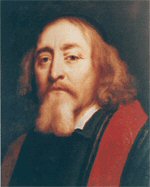
At the end of his life, from 1656-1670 lived Comenius (1592-1670) in Amsterdam, he lives a while on the Keizersgracht 123, the ' House with the heads ' of his protector, the rich metal and arms dealer Laurens de Geer (1622-1666). He stood at the head of a small Tsjech printing and publishing company. From 1662 he was also a member of the printers guild. He provides education to mayors Pieter de Graeff (1638-1707) and Nicolaas Witsen (1641-1717).
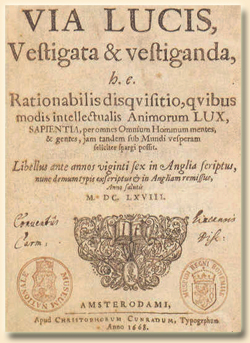
Comenius opposes abuses of the new capitalism, rejected the exploitation of the colonies and sought support in mysticism. Selfishness in man can be, according to him, the best combat through education. In his ' Great education learning; the full art all people to learn everything ' he suggested that everyone must go to school, because everyone has the same instance to learn. Also women and arms belonged to get an education.
The idea of al-improvement repeatedly reverts back (Clamores Aliae, 1665-1670). He even offers a far-reaching hand in reconciliation to the Pope and the Jesuits and does not hesitate to criticize dogmatists in own ranks. After his experience with monarchies he speaks his sympathies for a Republican establishment. He devotes a part of his ' General discussion ' to the future establishment of the peace-loving world, where he is the creation of a World Federation of peoples and States and the foundation of three universal institutions that a safe and harmonious development of mankind must guarantee: an international Peacecourt, a oecomenic religious constitoire and an international seminar for the dissemination of knowledge and scientific insights.
In 1668 appears VIA LUCIS (all written in 1641) at CHRISTOPHER CUNRADUS (right). It is already written in 1641 when Comenius stayed in London, where his main goal is the establishment of the College of the light, the first Academy of Sciences that would gather scientific insights and technical innovations to the light of knowledge at the service of humanity to spread all over the world. As he reflects on where the ' college of light ', that the beginning of the rebirth of the human society ' must usher, he has first time especially on the London Eye. Later a Moravian town, Prague and Amsterdam. His pansofic desire finds much resonance at a number of European Protestant scholars. He has a lifelong friendship with Samuel Hartlib and John Dury (born in Elbing)
.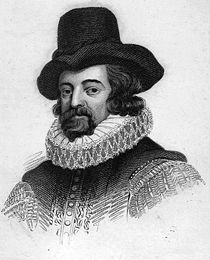
De influential group of English scholars around Hartlib saw a drop in the work of Comenius of the ideas of FRANCIS BACON (left). The English reformers established much hope of Comenius ' project of the ' al-improvement of mankind '. There were attempts for a perpetuum mobile. It had to be the accuracy of the pansofische thought about the harmony of the universe confirm and also provide a new source of energy humanity. In 1670 speaks Comenius came out in favour of a Republic. To the Hartlibians also heard the arabist Edward Pococke (1604-1691); he occupied himself with the translation of ' Life of Hayy ibn Yaqzan' of Ibn Tufayl. Later, this sequel is done by his son Edward (1648-1727) and in Dutch translated by Johannes Bouwmeester and published at Riewertsz.
5, 1, 25, 40, 41 44. DESCARTES (Descartes: 5. Kalverstraat, 25 met opschrift: Westermarkt 6) AND OTHER SCIENTISTS (CLASSICIST HOUSE of HUDDE (architect Vingboom, Singel 284); (Locke, 41. Damstraat, 40. Westermarkt)
Under the influence of Descartes, the sciences go in a new direction. At the University there is a battle between cartesians and others. Descartes is based on empirical observation that everything is subject to laws of cause and effect and is the father of modern science.Although in Descartes ' system there is actually no place for ' above'natural, he stcks himself tot the traditional image of God. He also remains himself Catholic.
Actually the on perception-based method is not suitable to study the human mind (still the possibilities are limited). By this he takes no distance from the negative image that man has about himself by the dogma of the Fall and the thereto belonging disciplining by punishments in the hereafter. God and Nature than in Spinoza's works fall really together. This allows mankind to accept themselves and to get more views pointed out how to 'perfect' themselves together with the surrounding world.
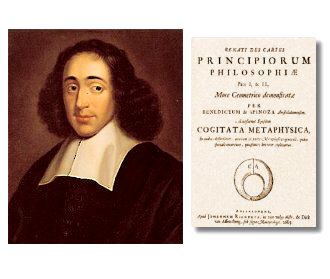
Spinoza puts the scholastic topic "human happiness " central and is also able to apply the new methods. For the cartesians, he is a partner, who speaks their language.
SPINOZA ' AMSTERDAMMER ' about DESCARTES ' PRINCIPLES of PHILOSOPHY/METAPHYSICAL THOUGHTS (1663)
Differences between Spinoza and Descartes are
1. as regards the method: Descartes doubts everything we know if that is true knowledge is (only that we think and therefore exist, we should assume). Spinoza thinks we have of much ' about '-true knowledge and that this intuitive knowledge can also be used. It is good to use this with the appropriate method and (logical) thinking and this way to transform as much as possible to true knowledge. Knowledge develops gradually (asymptotic). Since we necessarily also erroneous representations of affairs, also constitutes the removal of erroneous representations part of acquiring true knowledge (in the line of Bacon).
2. Spinoza's conclusion about the humans is that they should try to moderate certain passions and associated emotions , but not necessarily suppress, what is according to Descartes and in line with performances from different religions. Indeed, emotions belong to our Nature and ' natural law '. Through knowledge, we can increase our ' emotion management ' and therefore get ' more appropriate ' and happier lifes; we can make 'our lives more ' perfect .
3. There is also a difference in understanding the laws of motion, this is Spinoza assuming that everything moves amid a moving world. This exerts pressure on all sides, which also constantly at loss of pressure movement can arise. While Descartes movement is caused by transfer of only one movement impulse (see Klever on Cuffeler).
Although Descartes puts not long before Spinoza an immense leap forward, which was not yet processed, Spinoza already puts the next step by using the logic. At the request of the 19-year-old student in the Carthesian philosophy in Leiden Caesarius, Spinoza writes in Rijnsburg a summary of Descartes ' method, where he immediately makes some reservations (Metaphysical thoughts, COGITATA METAPHYSICA, see the cover top right; in it Spinoza suggests that a God that doesn't do miracles, might be more perfect than a God who needs miracles). In 1663 asks the Amsterdam Ethica-circle (see below) Spinoza to do this. It is conducted and provided with a preface by Louis Meyer and Spinoza's own name published by Jan Riewertsz.
OTHER SCHOLARS (Leiden: GEOMETRIC COMPANY AROUND FRANS VAN SCHOOTEN, Voorburg, including England) in addition to Leiden graduate doctors as Louis Meyer and Johannes Bouwmeester, who belonged to the close circle of his confidants in Amsterdam. Spinoza was in contact with known mathematician and physicists and physiologists, as Boyle, the Secretary of the Royal Society, Oldenburg and the Danish physiologist Niels Stensen (1638-1686). Also with the mathematician and philosopher Leibniz (1646-1716).
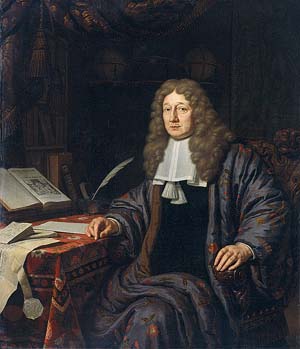 There are letters from 1666 of Spinoza known to the mathematician and physicist Johannes HUDDE (1628-1704) (left), who had been part of the ' geometric ' group of gifted students of the Leiden Professor Frans van Schooten Jr (1615/16-1660) who published himself in 1660 on Descartes. Possiblly Van den Enden has been the neighbour of the other side of the Singel Hudde. To the company Johan de Witt and Christiaan Huygens belonged too. In the Voorburg time, there was contact between Spinoza and mathematic and physica talent Christiaan Huygens (1629-1695). Between their respective work consists a striking resemblance in way of reasoning and formulate about the cosmos . Both had much contact with members of the Royal Society. In 1665 Christiaan Huygens to Paris goes to a French ' Royal Society ' to help to develop this. In Voorburg is Spinoza practically neighbor of Christiaan Huygens who comes to the family's outside house Hofwijck .
There are letters from 1666 of Spinoza known to the mathematician and physicist Johannes HUDDE (1628-1704) (left), who had been part of the ' geometric ' group of gifted students of the Leiden Professor Frans van Schooten Jr (1615/16-1660) who published himself in 1660 on Descartes. Possiblly Van den Enden has been the neighbour of the other side of the Singel Hudde. To the company Johan de Witt and Christiaan Huygens belonged too. In the Voorburg time, there was contact between Spinoza and mathematic and physica talent Christiaan Huygens (1629-1695). Between their respective work consists a striking resemblance in way of reasoning and formulate about the cosmos . Both had much contact with members of the Royal Society. In 1665 Christiaan Huygens to Paris goes to a French ' Royal Society ' to help to develop this. In Voorburg is Spinoza practically neighbor of Christiaan Huygens who comes to the family's outside house Hofwijck .
Spinoza's strength lies mainly in the fields of mathematics and logic, not on extensive own empirical research. He may have his theorem that all beings are formed on the basis of the ' conatus ' (commitment to self-preservation) derived from what he saw through his lenses. Physiologist Stensen tells that Spinoza was interested in his brain research: ...In that time (1661-1662) he came (Spinoza) during several days every day with me watching my anatomy of brain, which I ran on various types of animals, to discover the place where the movements occur and where the sensory sensations end. ... 'Although he tried like Descartes to obtain physicist and anatomical knowledge as much as possible , Descartes ' physiological and Huygens ' physicist knowledge seem to be more modern than that of Spinoza. His possibilities of access to academic knowledge was also significantly less. Christiaan Huygens, who in 1690 as first stated light as golf phenomenon, had his light-theory only after Spinoza's death around.
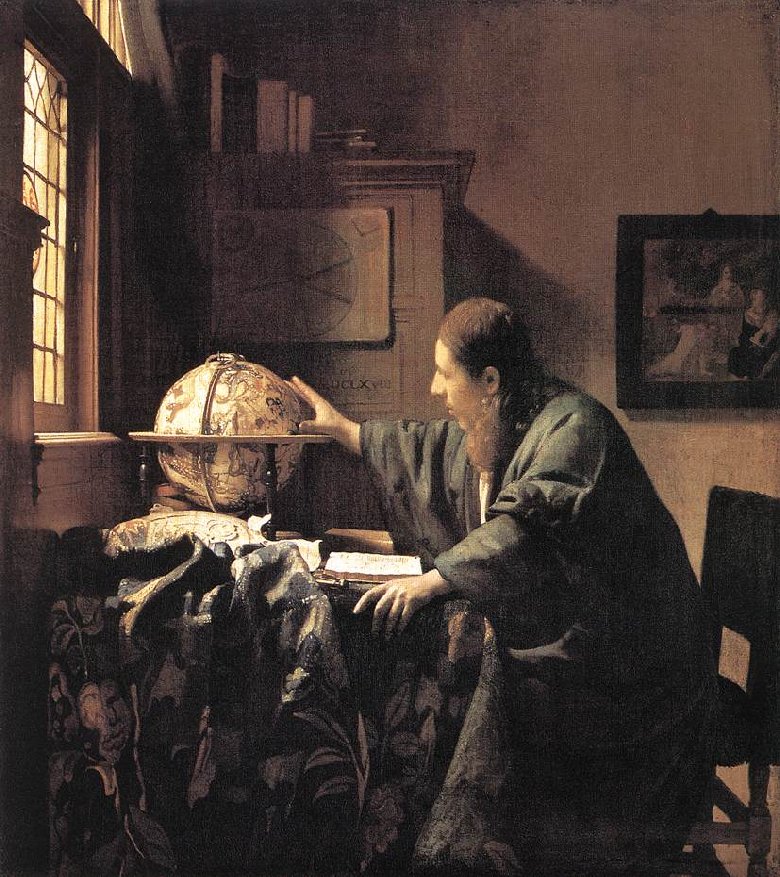
To for example Rembrandt's painting the night watch ' and ' Vermeers ' ASTRONOMER ' (left) shows how much the light in this time plays a role. Also in painting. Probably there was a treatise on the Rainbow by Spinoza.
Several Dutch scientists from the circle of Van Schooten were important political functions. Hudde lateron became a part of the vroedschap of Amsterdam and was later appointed many times as one of the mayors. Gillis Valckenier was his cousin. Johan de Witt became Grand Pensionary. Christiaan Huygens Cosmotheoros ', in which he his brother Constantine lints on a journey through the universe, speaks himself also out about power and war; It appears in 1698 (Icke). Both his father and brother Constantine played an important role in politics and the arts. Spinoza sends Christian its national work, TPT, to his pleasure.
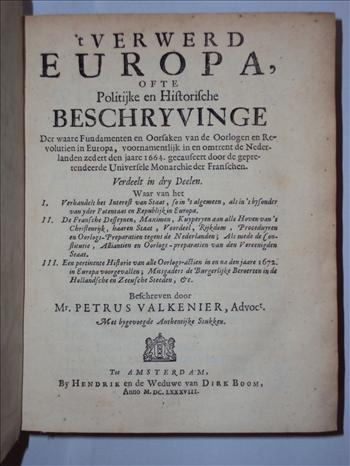
GEOMETRIC STATE ENGINEERING
This reasoning applied to European States can also be found in (right) ' 't VERWERD EUROPA ofte, Politijke en historische beschryvinge der waare fundamenten en oorsaken van de oorlogen en revolutien in Europa, voornamentlijk in en omtrent de Nederlanden zedert den jaare 1664, gecauseert door de gepretendeerde universele monarchie der Franschen ' (1675; published by endrik en de Weduwe van Dirk Boom, Amsterdam) of Petrus Valckenier, in which he accurately shows the factors balance of the various States with the purpose to indicate expected conduct of wars.
The concepts are akin to those of Spinoza and the la Court. The rationale is closer to that of Spinoza because he takes moral factors, human values, as forces. An important factor in the Netherlands is that the Dutch after the rebellion got attached to value his freedoms: freedom of conscience, freedom of thought. He thinks that (some) people find these more important than their own lives. In line with the natural philosophy of Hugo Grotius he finds that a State must do everything to defend itself (this is a natural law), but that an increasing influence with the consent of the other party must happen, for example, that a Covenant is made. He argues simultaneously for one privileged Church (this is in accordance with the situation as it existed in the Republic). This may have to do with the fact that he believes that the moral force in time of war can be more powerful than of fragmented churches. The exact content of a belief is actually less important, since it still revolves around core values of that society. Behind the scenes of the big politics Valckenier has much influence as Advisorfor William III and other politicians.
3, 20, 22. ADRIAAN KOERBAGH (convicted in 3. STADHUIS, DAM, see Van Moerkerken; 20. Rasphuis, Heilige weg; later Willige Huis, Schippersgracht; 22. coffin Oude Nieuwstraat 8; 3. buried Nieuwe Kerk)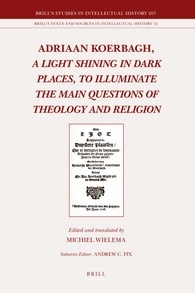
Adriaan Koerbagh's (1632-1669) father was a well-to-do plateel bakker from Bergen op Zoom and his mother a Dutch midwife. Adriaan studied medicine and law in Leiden. His father died when he was 12. His guardian was when Lambert Reynst (Amsterdam, 1613-Amsterdam, 1679), Amsterdam schout and burgomaster. Reynst is of the 'State-minded party' ('staatsgezinden') and family of Johan de Witt. In 1672, he is put of from the vroedschap. The law education was broad and practically oriented; the students had to mainly focus on Roman law and combined with Hugh the Great ' Inleidinghe to the Hollandsche rechtsgeleerdheid ' (1631) they had to the Dutch law.
Koerbagh wanted to encourage scholars to speak their native language, so he writes in 't Nieuw Words-book of Laws'. His book was also intended for those who use Latin words to do if they are very scholarly. 'Like indian birds, whem the mimic the words of humans'. His later ' Bloemhof ' appears under name of the printer.
He was through the study befriended Meyer, Bouwmeester and also with the translator of Leviathan Abraham Van Berckel. Except doctor, he was also a jurist. He wrote the book on Spinoza's work closely related to religion in philosophical speech lines (see right). Previously he had written. This is called a ' hurtful ' dictionary. Van Moerkerken: ' it seems a "General dictionary of Bastard words ', but in reality it is an alphabetically-ordered combat of any dogmatic religion and in particular the Christian '. Koerbagh wrote in the line of Louis Meijer ' New dictionary of Laws ' (1664). Here he takes the lexicographic work of Meijer as a base and add there own comments and ideas about the law. It is known that Adriaan Koerbagh had books of Dirck Volckertszoon Coornhert and Comenius is his bookcase.
As a jurist he mocks the Corpius Juris, which he called a very large book which also many clean jokes and unnecessary laws. ' In a half as thick book one could write in our own language, more clear and in a shorter way more and more necessary laws than there are i in the entire Roman code. But so are we, free people according to his own saying, and yet binding us as fools bind to task and laws of another people. It seems to let know, or one so that God had given to the pagan peoples more wisdom and sense than us '.
At ' Loy, law ' stands: ' The legal scholars know yet just like Plato, who once said: "when people have a lot of laws there are also many contentions or evil use". From the crowd of contentions and dissensions legal scholars have advantage. Justinus, a Roman historian, recounts of the Scyths that they lived more wisely than the Greeks with little laws with all their laws and learnedness. The Romans had also very many laws, even more than the Greeks. Yet they have lived in murder, robbery, on purpose and all kinds of excess. So it seems that, where many laws, many breaches have place; where few laws are, few infringements '.
The tragic sequel is pretty well-known (partly because the report by Hans Bontekoe in Van Moerkerken in Bontekoe), although around the exact circumstances much is unclear. The Utrecht printer van Eede of 'The Light ... ' ceased the printing halfway because of the content and went along to the authorities. The consistory had already addressed the Amsterdam magistrate at work, initially thinking that the work came of brother and future Pastor Johannes Koerbagh and there had already decided to action. The Consistory had put heavy pressure. For them also played another role that Koerbagh lived unmarried with a woman with whom he had a child.
Adriaan Koerbagh seems to have held outside shot during the process his study friend Johannes Bouwmeestert. Also about Spinoza says Adriaan Koerbagh that he has visited him only once, but that however, he had his knowledge of Hebrew not from him.
The outcome was that Adriaan in July 1668 was sentenced to 10 years in prison, an extremely heavy penalty, then later exile. John was quickly released. Adriaan Koerbagh began the criminal to sit out the penalty in the Rasphuis on the Heilige weg (20) and died in October 1669 died in the 'Willige huis ' to the Schippersgracht, where to he was transferred. The consistory, had requested an investigation into how it went with him in the Rasphuis. The reporting of Reverend Vinckius left, however, more than a year. Koerbagh died a week after his reporting.
His younger brother John (1634-1672), theologian, also convicted in the same time to a comparatively light punishment. He continues to preach in its own way. From the protocols of the consistory, shows that he is speaker on a well-visited meeting at the Rokin and has ' defamatory spoken about our Saviour Jesus Christ and against ' syn eternal godtheyt and voldoeninghe ... ''. John and also sister Lucia die several years after Adriaan in 1672. They are buried in the new Church.
It is still a question why it is went like it went. Did the brothers really went too far? Of Koerbaght is known that he just like the sacrementarians denied the real presence of Christ in the sacrement of the evening meals. With a ban of the States on the socinianism probably also this doctrinewas prohibited . Was it the younger brother who was threatening to the Church? Was it the political situation, in which the Calvinists and the army had to play a larger role again? Was it newer insight after the appearance of the Leviathan in the Dutch? Played a role that people outside Amsterdam were involved, including Van Berckel? Or was it actually directed against the Republican Mayor and guardian of the brothers Lambert Reynst? Even Hudde supports the penalty and also this belongs under the responsibility of his cousin Gillis Valckenier. 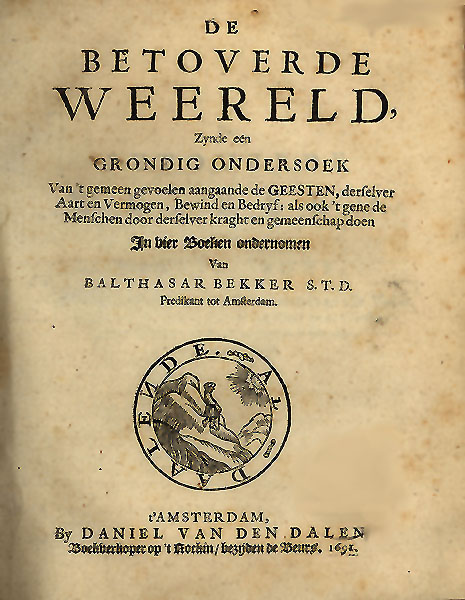 Nevertheless will these two as mayors appointed Rieuwertsz a few years later in 1675, who edits comparable books as city printer and give him protection this way. Had they expected that the soup not so hot would be eaten as hot as it was served and that they could have exiled Koerbagh after a short time ?
Nevertheless will these two as mayors appointed Rieuwertsz a few years later in 1675, who edits comparable books as city printer and give him protection this way. Had they expected that the soup not so hot would be eaten as hot as it was served and that they could have exiled Koerbagh after a short time ?
In 1691 appears ' The enchanted weerelt ' BEKKER (1634-1698) or Balthazar, a book about witches that like Koerbagh's is a controversial book. It was published by a printing company, which, like that of the young Rieuwertsz was located near the stock exchange building . Amsterdam and some cities did ban the book, but not the States of Holland. Bekker, who is pastor of the Church may not preach, but the salary paid to him by Amsterdam.
18. CAUTE! (Dirk VAN HASSELTSSTEEG 't Martelaersboek) 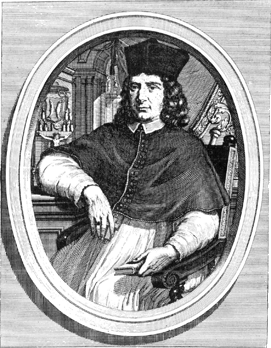
Innovative scientific ideas call resistance. On the point of religion especially among the common people. Spinoza seems to be aware of this and has some understanding for it. All thinking is limited by the limits of human comprehension. As scientists already can get only a limited insight, then that applies to a greater extent the population, whose comprehension is initially focused on everyday things to ' persevere ' in existence.
The scientific world knew the history of Giordano Bruno (1548-1600) and Galileo Galilei (1564-1642). Self knew Spinoza the history of exile-for-ideas from the Jewish community of Uriel da Costa (1585-1640) already earlier than his own exile. Publisher Riewertsz must have been informed about the decision of Descartes to pass most of his work after his death . At that time there were already rumors about the possible cause the deathof Descartes or the suspicions about the death of Pope Adrian. In any case, the group around Spinoza, who is involved in the publication of his work, respects the wish that most of his work is published only after his deathand not on his own name . Rieuwertsz was so careful not to mention his name as a the publisher and he gave the place of publication for example ' Hamburg ' instead of ' Amsterdam '. The TPT is prohibited by the Court of Holland in 1674. Riewertsz had already taken larger than usual precautions at the first edition : no author on the title page and for the publisher H. Künrath, Hamburg. Künrath was an existing person, was an alchemist and Rosicrucian, not living in Hamburg. In later editions he used other names. In a later edition, in which he spends in one band with the TPT Meijer's ' Philosophy, interpreter of Holy Scripture ', he uses the names of Heinsius and Sylvius.
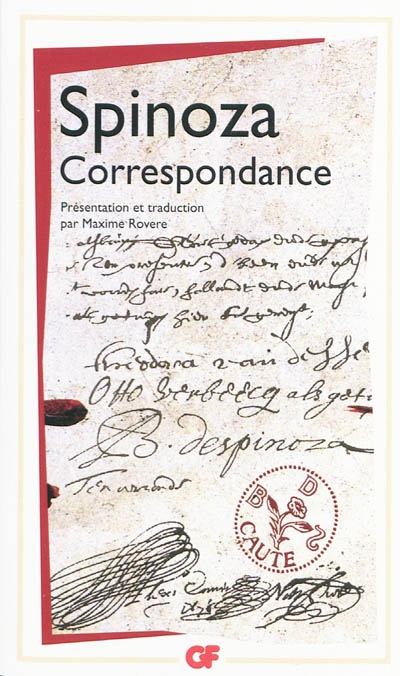
A benefit was that Spinoza had ambition not like Meijer to share the common people in his scientific ideas.His work was in the first place meant for the more educated part of the population. For scientists and also for theologians. Especially the latter formed a conduit of new ideas to the population. Therefore, he wrote in Latin, which work could not reach the ordinary people not directly and would give less offense feelings among ordinary people, who had not learned the scientific way of thinking.
When Spinoza corresponded, he reminded the reader to exercise caution by clicking his stamp "CAUTE" (left), ' beware to the letter.
When rumors reach Rome just after Spinoza's death that work of the "atheist" Spinoza is going to be published, Cardinal Barberini command to the Archbishop of Utrecht, Johannes van NEERCASSEL (1625-1685) (top right), to find this out. He will question Rieuwertsz. Recently has become known that a yet unpublished copy of the Ethica through another line, namely through Tschirnaus-Stensen, has come in the Vatican rightly. Then a ban by the Vatican follows.
17, 18. IN 'tMARTELAERSBOEK; JAN RIEUWERTSZ (VAN HASSELTSSTEEG northside near thej Nieuwe dijk, formerly nr 14); 18. Tymon HOUTHAAK (corner NIEUWE ZIJDS KOLK); Simon Joosten de Vries, Singel 112 (formerly 'De Vriesche Boer')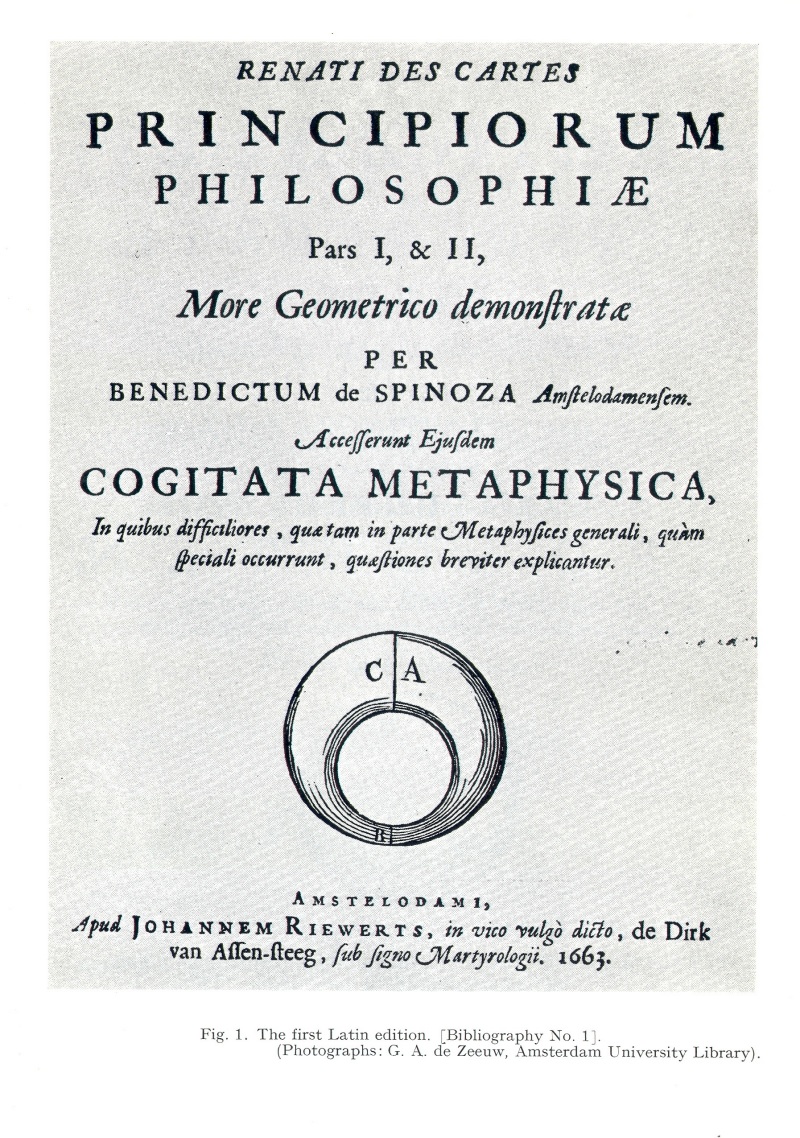
JAN RIEWERTSZ
Spinoza's work is published by Jan Rieuwertsz (the old, later the young). Rieuwertsz ' publishing and in 1649 open book shop In ' tMartelaersboek in the Dirk Van Hasseltssteeg (see for example links at the bottom of the title page: VAN ASSEN-STEEG ...Martyrologii).
IN 'tMARTELAERSBOEK
Inside one could freely speak about religious and Scientific Affairs. The title of the publishing house refers to books, that were intended to keep the memory alive of people who had witnessed against the established order their new insights, even if they were paid with death. Well-known Dutch martyr books are: ''De gheschiedenisse ende den doodt der vromer martelaren' van Adriaen Cornelisz. van Haemstede (1559); het doopsgezinde 'Offer des Heeren' (1562) en het 'Haarlems martelaarsboek' (1615). Before Rieuwertsz came here lived engraver and printer Claes Jansz Visscher (15587-1652) and had his company . He had made and published many engravings made of executions of Anabaptists. Also the famous engraving of the beheading of Johan van Oldenbarneveldt made by him.
In 1675 Rieuwertsz was appointed partly with help from Mayor (and scientist) Johannes Hudde (1628-1704) city printer. It seems that ' Rieuwertsz ' has understood well Spinoza's Caute. This is true for all men, who were directly involved in the edition of Spinoza's books. It is striking that none of these Gideonsbende's portraits are known. Perhaps out of caution. The men put themselves in the service of their mission to spend to do this type of work. There must have been a great mutual trust.
RIEWERTSZ and SPINOZA
Spinoza would have been in contact with Rieuwertsz because he corrected proofs to earn money. When Spinoza lived no longer in Amsterdam, he has stayed here (Nadler) and he used the address as an address every now and then.
ETHICA-GROUP
Several persons of Riewertsz publishers group (see below) were also in the small circle of Amsterdam's friends, who discussed the nearly completed portions of Ethica. Like: Simon Joosten de Vries, Dr. Louis Meyer (1629-1681), Johannes Bouwmeester (1630-1680). and Jarig Jelles (1620-1687), Pieter Balling. Presumably also the brothers Adriaan Koerbagh and theologian Johannes (1634-1672).
Some of them also wrote work, closely related to that of Spinoza, which is also from the titles suggests. Balling wrote a spiritualistisch work ' Light on the candlestick ' (1662). ' Light ' is with him 'reason', by which a man can know God, in which knowledge is our salvation and which we can know by looking inward. There we find the true guideline. Therefore nobody can dictate to another. This work was translated into English in 1663 also issued by the quaker William Ames (according to Akkerman Adam Boreel could alsobe yhe author). He also wrote about the inadequacy of words; Meyer had a dissertation written about ' movement and rest ': ' Matter and its states, motion and rest '. In letters to Spinoza him were questions submitted refering the first chapters of the Ethica, which was set up according to the mathematical method, whereby a think system is built on the basis of definitions.
THE EDITORGROUP
JAN RIEWERTSZ (1617-1685) (the Publisher, collegiant and Mennonite, who at his death donated to the Mennonite movement ' Waterlanders en Vlamingen', but did not belong to them, earlier edited work of Louis Meijer and translations of DESCARTES; further work of collegiantenleader, mennonist referend, socinian/unitarianist and alchemist Galenus Abrahamsz de Haan en Dirck Camphuysen, de Remonstrant poet from whom a poem stand on the house in Rijnsburg; in 1658 a translation of the Qur'an (in Arabic provided by ' Tymon Houthaack for Jan Riewertsz '). In 1671 work of collegiant Reverend Cornelis Moorman (1600-1660). In 1672 appears at Riewertsz IBN TUFAYL's 'Het leeven van Hayy ibn Yagzan (translation based upon Pocockes Latin translation from the Arab from 1671). In 1684 Riewertsz edits a work of Abraham Cuffeler (1637-1694) (transl. 'Proeve van natuurlijke en kunstmatige redeneerkunst, leidend tot de beginselen der alwijsheid'; publishers-pseudonym: 'Künrath, Hamburg') and in 1687 of derived from Görlitz Tsjirnaus (1657-1708) 'Geneeskunde van de ziel of een proeve van authentieke logica'. Both authors write in the line of Spinoza and knew his work (Klever).
JARIG JELLES (1620-1683) (probably the lender, ' mercator sapiens ', good friend of Spinoza, akin spirit, Mennonite, collegiant, member of Ethica-study group). He wrote in 1673 ' Belydenisse des Algemeenen En Christelyken Geloof' (published by Rieuwertsz), in which he argued that Christianity and the doctrine of Descartes can tolerate each other well. He used biblical terms to express his philosophical thoughts. He denies that the human nature in itself is corrupted. Attention of him for the natural sociability of human beings, about which Spinoza in his Ethics writes also. He wrote the foreword for the Opera Posthuma and was together with Louis Meyer one of the editors.
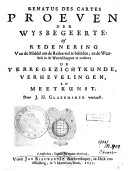 JAN HENDRIKSZ GLAZEMAKER (1619/1620-1682) (the translator of Latin to Dutch. Father of his wife Catelyntie, whom he married in 1651, was mathematician Sybrandt Hansz. Cardinael( 1578-1647). He was one of the two ' scientific ' Mennonites because of whom the ' First Nederduytsche Academy ' had to close. Through him, Glazemaker learned to know Descartes whom he translated. In the preface to his translation from 1659 of Descartes ' Proeve der Wysbegeerte: of Redenering van de middel om de Reden wel te beleiden, en de Waarheit in de Wetenschappen te zoeken; de verregezichtskunde, verheveling en meetkunst' Glazemaker thanks an unnamed "friend", who knes a lot of geometry and has helped him in translating . This will probably have been Spinoza , what then shows that they helped each other). This means that Spinoza already during the 1950s already intensively has deepened himself in the texts of Descartes ' . Also that the group had experience with the solution for this controversial work to pablish it only after the authors death.
JAN HENDRIKSZ GLAZEMAKER (1619/1620-1682) (the translator of Latin to Dutch. Father of his wife Catelyntie, whom he married in 1651, was mathematician Sybrandt Hansz. Cardinael( 1578-1647). He was one of the two ' scientific ' Mennonites because of whom the ' First Nederduytsche Academy ' had to close. Through him, Glazemaker learned to know Descartes whom he translated. In the preface to his translation from 1659 of Descartes ' Proeve der Wysbegeerte: of Redenering van de middel om de Reden wel te beleiden, en de Waarheit in de Wetenschappen te zoeken; de verregezichtskunde, verheveling en meetkunst' Glazemaker thanks an unnamed "friend", who knes a lot of geometry and has helped him in translating . This will probably have been Spinoza , what then shows that they helped each other). This means that Spinoza already during the 1950s already intensively has deepened himself in the texts of Descartes ' . Also that the group had experience with the solution for this controversial work to pablish it only after the authors death.
LODEWIJK MEIJER (1629-1681) (for the general editorial work, e.g. lexicographer, hard worker, was in Amsterdamse Spinoza's Ethica-group; see also under ' Schouwburg and NIL ' and ' the first Neederduytsche Academy '). In 1668 Riewertsz publishes anonymous ' Philosophia Scriptura Interpres '. In the foreword Meijer praises Descartes: "the author of this happiest and finest method was the noble and matchless Renatus Descartes '. In 1674 Riewertsz publishes it again, along with Spinoza's TPT (both anonymous). In this way Rieuwertsz directs expressly to cartesians also.
Louis Meyers work and ambition iareparticularly located in translating Latin words and scientific concepts in the Dutch, which makes it possible that the ordinary Dutchman could take knowledge of scientific thinking in his own language. Meijer is also Theatre-man, one of the directors of the theatre, which is ultimately a strong mathematical (geometric) and classicitic thinking and will write a Handbook for Theatre: the Naauwkeurig onderwijs in de toneel. To his grief he came little to writing plays.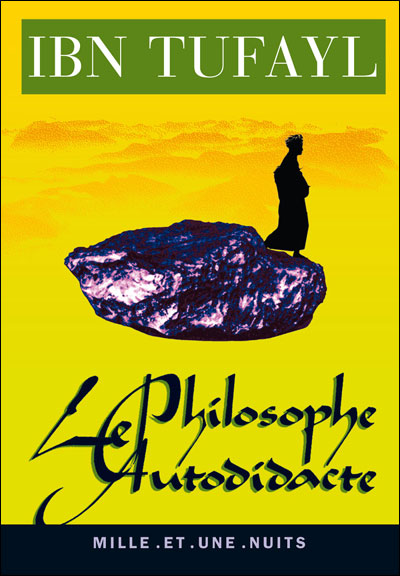 JOHANNES BOUWMEESTER (1630-1680), a very good friend of Louis Meijer and further from Spinoza, Franciscus van den Enden and Adriaan Koerbagh, did also editorial work. He was a good translator, who sometimes improved a translation of Glazemaker (Akkerman). Further translated Bouwmeester IBN TUFAYL's 'Het leeven van Hayy ibn Yagzan'.
JOHANNES BOUWMEESTER (1630-1680), a very good friend of Louis Meijer and further from Spinoza, Franciscus van den Enden and Adriaan Koerbagh, did also editorial work. He was a good translator, who sometimes improved a translation of Glazemaker (Akkerman). Further translated Bouwmeester IBN TUFAYL's 'Het leeven van Hayy ibn Yagzan'.
18. TYMON HOUTHAECK (1625-1664) is often referred to as the printer. He pressed also known under the name Johan Brakel. Except printer he was singer and actor. The address is corner Nieuwe Zijds Kolk (also called 'de Vogel Struis'). His father (1597-1658) had also already had a printing office, gave out pens and ink, printed plays for the theatre and was further supplier of beer.
PETRUS VAN GENT (kopiïst, doctor in medicine).
PROTECTION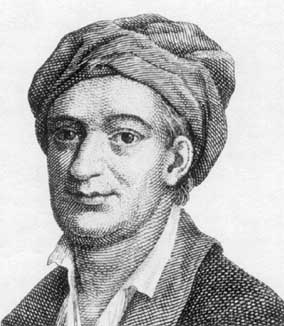 With the protection of these concerned Publishers group, that was well aware of the opposition that authors with new groundbreaking ideas get, Spinoza was probably able to complete his work in their discretion and needed not 'to put water in the wine' (writing things different as he wanted), such as possibly Locke (according to Klever), who had to be careful alik with his editor Jean Leclerc. Jarig Jelles (foreword) and Louis Meijer (editor) took care of the edition of the ' Opera Posthuma '.
With the protection of these concerned Publishers group, that was well aware of the opposition that authors with new groundbreaking ideas get, Spinoza was probably able to complete his work in their discretion and needed not 'to put water in the wine' (writing things different as he wanted), such as possibly Locke (according to Klever), who had to be careful alik with his editor Jean Leclerc. Jarig Jelles (foreword) and Louis Meijer (editor) took care of the edition of the ' Opera Posthuma '.
Or confidence in Schuller was justified, is the question (he was much in debts). Schuller played work of Spinoza to Leibniz in the framework of a failed alchemical project together with Galenus Abrahamsz (period 1675-1680). LEIBNIZ (1646-1716) had much interest in and affinity with Spinoza's work and with the pansofic thinking.
That is not to say that the group and the other friends always agreed with each other and with Spinoza. With Spinoza there were in addition to a lot of agreementst, differences in opinion between him and Meijer (and thus possible to the Paris averroists) (zie Sutcliffe, Akkerman, and this website: Theatre/NIL and 'Rembrandt and NIL') and Koerbagh and Spinoza.
Certain contradictions of the many within the former Republic (eye/ear; war and peace; and with whom; State-or Prince inclined; God or nature; own thinking or general authority; government by the few or many; cartesian or not) did not pass by this group. Spinoza-himself shows to be not only an utopianist (improve the world by developing ' true ' and especially ' adequate ' knowledge) to be a realist (everything is the result of the operation of laws and therefore for now ' perfect ').
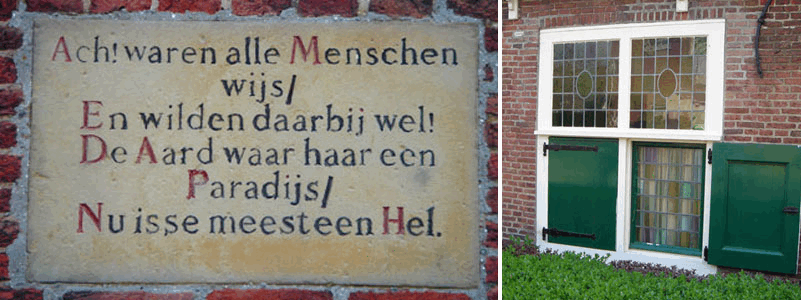
The PUBLISHERS FUND RIEWERTSZ
Riewertsz publishes in addition to Descartes and Spinoza much works of collegiants: CAMPUYZEN (see the legend of the Spinoza House, Rijnsburg, above) and Moorman. Overlooking the publications of Riewertsz they show a larger kinship with collegianten-foreman Adam Boreel and the Royal Society (take also the translation of Tufayl) than with Koerbagh and Van den Enden, who both were not in the fund of Riewertsz. Spinoza's thinking also seems more akin with those first-mentioned. That Riewertsz published Cffelers 'Specimen artis ratiocinandi naturalis & artificialis ad Pantosophia (!) manuducens; proeve van natuurlijke en kunstmatige redeneerkunst, leidend tot de beginselen der alwijsheid', strengthens this idea yet.
SPINOZA'S WORK WHICH WAS PUBLISHED DURING HIS LIFE

To DESCARTES ' PRINCIPLES of PHILOSOPHY/METAPHYSICAL thoughts (1663) is above allready a few times refered. There exists in certain (scientific) circles much interest in this work, partly because of the criticism on Descartes. Although there are many points in agreement with Descartes ' work, the ultimate conclusion to which it leads, namely that God does not exist (despite Descartes ' dualism and its own fidelity to the Catholic faith) and the cold mechanistic worldview, calls resistance. While Spinoza's work does not violate reality and leaves still space for the experiencing God. This fits well with the ideas of Constantijn Huygens, Adam Boreel, the Hartlibians and members of the Royal Society.
THEOLOGISCH POLITIEK TRACTAAT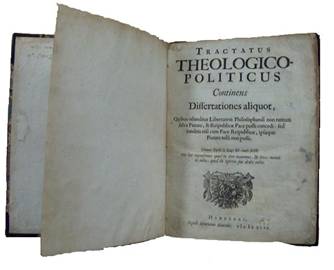
Spinoza begins to write the Theologic Political Treatise in 1665. An important sociological-theoretical work e.g.. because of the desirability of separation of Church, State and science, which Spinoza reasoned stands for. It appears at Riewertsz in 1670 and together with Lodewijks Meijers ' Philosophia scriptura Interpres ' in 1674. To Oldenburg he writes from Voorburg about the reason to start the work: ' the opinion that ordinary people about me cherishes, that does not stop accusing me of atheism; I feel forced to avert thought as much as possible '. He had come in a threatening situation when he was called by representatives of the reformed church in his residence Voorburg publicly ' a dangerous instrument of the Republic ' and he sees himself obliged to defend himself.
In the following years comes great attention to Hobbes ' Leviathan ' about the State, which English translation appears in 1668. Already before Pieter de la Court (1663) and Franciscus van den Enden wrote on the State (1665). There is talk of increasing threat of war from different sides. This might gradually have got also a place in the work. It fits in his thinking to want to dò something (with ' praxis'-targeted words; see about TPT and praxis the close-reading of Roothaan). In any case Spinoza let down his work on the Ethics for quite some time.
In the political and Theological Treatise is repeatedly referred to Alexander the Great in critical sense. Hj might indirectly refer to Louis XIV. In this way to refer indirectly to a current situation was quite usual in the theatre and in the visual arts. By taking examples from antiquity or from the Bible was commented on current circumstances which were not in particular named, but were easily recognized by the viewer. In TPT, 17.6 Spinoza discusses how Alexander the Great himself deified in order to pursue its own goals and to be able to govern as a tyrant. Spinoza argues in his entire work is precisely that people their own (common) interest and therefore has preference for a democracy and not a monarchy.
'Let the people see me as a half God, "murmurs Alexander, ' they will let go my interest before their own interest '.
First sheet, chapter format and prefacee give the ultimate intention. Despite the resistance that it called, it is possible that the book nevertheless has had a positive effect in the period in which it is written. The necessary financial contributions for the struggle for freedom against the French, came also from ' pacifistisch'-oriented circles with whom Spinoza and his publisher had much contact. Perhaps the influence on Petrus Valckeniers ' 't Verwerd Europe (1675) '. This work influenced William III and other influential politicians (see above).
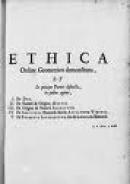
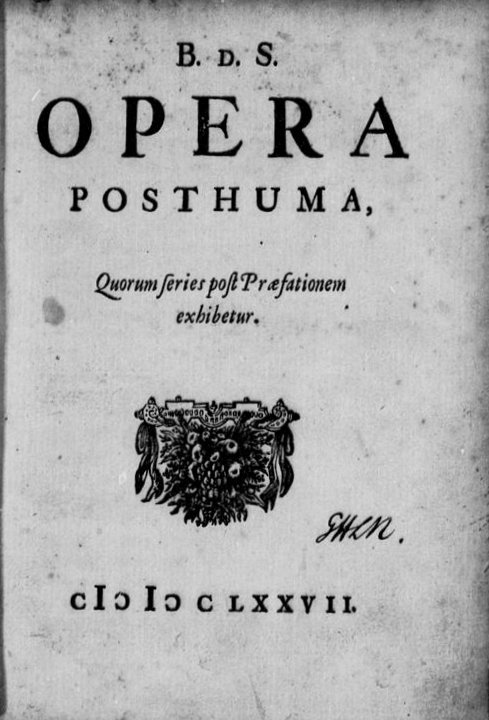 OPERA POSTHUMA
OPERA POSTHUMA
After his death in 1677 published in the Opera Posthuma (de 'Nagelate wercken'):
Ethica,
Emendatione
Cooerspondencen
Politiek Tractaat
Rieuwertsz publishes it out without mentioning the publisher name and the place of issuance ' Hamburg '. The Edition is provided by Jarig Jelles and Lodewijk Meijer. In de Opera Posthuma a portrait with subscript.
In the unfinished Political Treatise that Spinoza writes after 1672, he seems to have drawn the conclusion that democracy, for which he in the Theologicial Political Treatise had pleaded, still left waiting. Whatsoever, the one monarchy is not the other. In a monarchy, so he suggests, one should ensure as much as possible that the power of the monarch cannot expire to tyranny and ensure that it is adequately restricted. And a people's army, for example: rather than a mercenary army. Because in that case the power comes closer to the people-themselves. The Opera Posthuma are half a year after appearance banned by the States of Holland and Westfriesland.
INTERMEZZO
'Al wat geschapen is, streckt tot zyn behoudenisse. Tot behoudenisse van alle gheheel voordert de eendracht der deelen de gheheels. 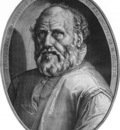 Dit gheheel is hier de menselycke nature, waar af elck mensch een deelken is. Als dan elck mensch doet zo hy ghaarne ghedaan ware, zo wordt niemand veronghelykt.’
Dit gheheel is hier de menselycke nature, waar af elck mensch een deelken is. Als dan elck mensch doet zo hy ghaarne ghedaan ware, zo wordt niemand veronghelykt.’
D.V. COORNHERT
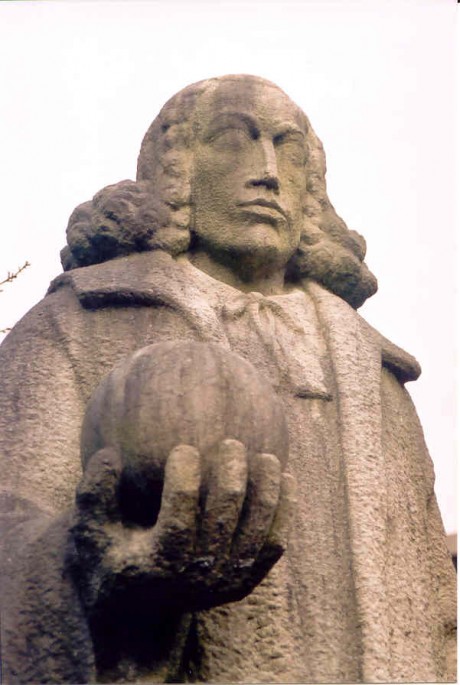 'Waaruit volgt, dat mensen, die door de Rede worden beheerst, d.w.z. mensen die onder leiding van de Rede hun belang nastreven, niet voor zichzelf begeren wat zij niet ook voor de overige mensen verlangen, en dus rechtvaardig, trouw en eerlijk zijn'
'Waaruit volgt, dat mensen, die door de Rede worden beheerst, d.w.z. mensen die onder leiding van de Rede hun belang nastreven, niet voor zichzelf begeren wat zij niet ook voor de overige mensen verlangen, en dus rechtvaardig, trouw en eerlijk zijn'
SPINOZA Ethica IV, 18 opm
'In het leven is het dus in de eerste plaats van belang het verstand of de Rede zoveel mogelijk te vervolmaken en in dit éne bestaat 's mensens hoogste geluk of zaligheid'
SPINOZA Ethica IV, aanhangsel IV.
SPINOZASTATUE (HILDO KROP)
Amsterdam-Spinozawalk ‘Evolution of mind’
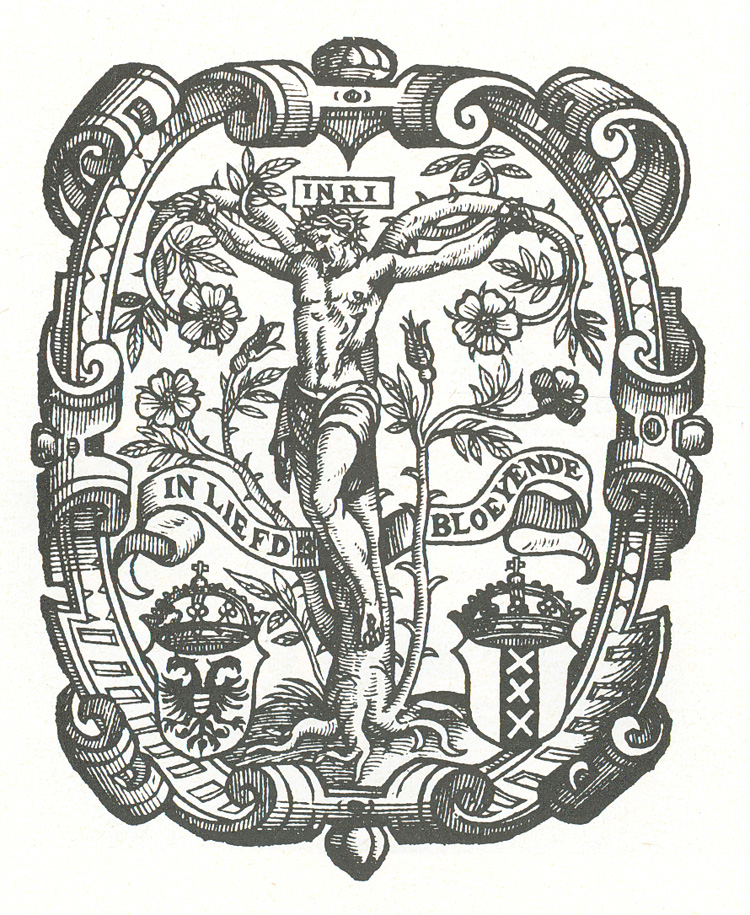
SYMBOL OF AMSTERDAM RHETORIC CHAMBER
d’EGELANTIER ‘IN LOVE WE FLOWER’
AMSTERDAM in the 16th and 17th century
SHORT SUMMARY 16th and 17th century developments in Amsterdam and the Republic
CHURCH AND STATE
In 1650 was Amsterdam on a peak. The revolt against the Spaniards was over. A large city House was built on the Dam and the enlargement of the city with the canals was in full swing. With the reformed States in Europe were coalitions formed and forged ties. France had with a visit of Maria de Medicis the Republic recognised. With the peace of Münster was the gradual reduction of 17 United provinces to seven of the Republic confirmed. The years between 1650 and 1672 knew (except diseases) new enemies: the English, who also won on New Amsterdam-country outside Europe and end 1960s fought the French under Louis XIV.
The city-holders Maurits, Frederick Hendrik, Willem II (died young in 1650) were succeeded by Johan de Witt in the stadtholderless period. In this period, Louis XIV makes preparations for war. It begins in late 1960s with territorial expansion, which leads to the intake of Utrecht in 1672. The 22-year-old William III is put in a form of city-holdership with close consultation with the States-General.
For the State law and the international contacts are important: Hugo de Groot; Furthermore, the diplomat Coenraat van Beuningen and 'Raadpensionaris' Constantijn Huygens.
In addition to religious freedom there is since 1579 a main church, the Calvinist, which is represented in the States and including care of Civil Affairs for non-secularism is. The officially recognized freedom of religion left space for non-Calvinists to the religion in house churches. This freedom brought with it an influx of people who were persecuted on religious grounds elsewhere, including many Flemings after the fall of Antwerp in 1585.
ECONOMY
The economy flourished. This was initially focused on the Baltic States: timber trade, grain trade, metal trade (including weapons). A certain degree of control was exercised so to monitor that the ' decent ' trade was. This contributed to many trade ran via Amsterdam. An important Amsterdams (trade) product was the book: in Amsterdam came many skills to create books together. In Flanders was the renaissance already further developed than in the more northern areas, mainly reflected in the painting and engraving art. This contributed to the thriving Amsterdam book printing company along with the rapidly evolving scientific knowledge in this period of ' scientific revolution '.
CULTURE AND RELIGION
In the Netherlands developed a Dutch renaissance (humans more than before) and classicism. The Italian trading cities and Flanders front herein were gone. Many Flemings brought this culture. The Italian cities were visited. Connected to the Florentine Court Ficino translated in 1471 the ' Corpus Hermeticum ', making knowledge of old pansofische and alchemical methods could be disseminated. Leonardo da Vinci gave attention to the harmonious, geometrical proportions of Vitruvius. The ' golden ratio ' was found. Culturally the rederijkerskamers played an important role. The most important was "In love bloeyende"-"of d'Egelantier. Started manifesting themselves on the streets, in the Nes, and later in the theater put it during more than a century, the show. There is a transition rather than thinking in specifically Christian imagination to a more universal natural philosophy. For some scientists is the traditional belief that contrary to perception, that for example the engineer Simon Stevin understandable believes that the religious content changes. But he (1590) sees a role for the faith and this would therefore in women and children should be encouraged. To a good education attaches much value.
Ecclesiastical leather pieces are increasingly outside the churches to freely discussed on collegiantenbijeenkomsten. In Amsterdam are Galenus Adr. de Haen and hebraicus Adam Boreel known collegiantenvoormannen. In rhetoricians and publishers circle consists interest Rozekruizersmanifesto's from 1614-1616. The travel and the development of microscope and telescope late new worlds. Constantijn Huygens (and many with him) comes to the conclusion that God is revealed not only in the Bíjbel but also by the "Book of nature". And later when with Descartes showed how an ingenious mechanics nature was, that there is a Divine architect. Cultural, religious and political area is the influence of Dirk Volkertsz Coornhert also after his death in 1590 large and identifiable.
During the 17th century discursive texts take an growing greater place in in relation to the visual and poetic (compact and with preservation of emotions): a shift from eye to ear. End 60-ties the culture one sees a new development; among other things, aimed at more standardisation in the language. In many areas, knowledge is systemized in encyclopedias. The old Theatre directors, including Vondel, must make way for the by Louis Meijer established NIL, what is strongly French oriented. The realistic paintings of Rembrandt will not fit in the high ideals of the painters of NIL.
SCIENCE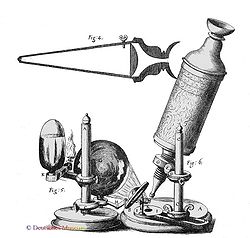
The development in the sciences and the possibilities of the applications had a broad interest. This went together with a desire to learn this in their own language, wide spread knowledge would then be possible. Amsterdam was, however, no University permitted and certainly no one in which the Dutch the official language was. Nevertheless could scholars who were persecuted elsewhere, here in compliance with certain caution, walk around freely. Even the controversial Descartes, who had influential protectors in Netherlands and the Dutch universities got here the first foothold with its mechanistic determinism. In combination with the publishing houses, this led to outside-academic exchange of science. There were contacts with English scientists who met outside the official University channels and an international exchange of knowledge stimulated by the effort of making and transleting bookf, who only much later found an official Royal recognition found in the establishment of the Royal Society.
STATE
Science at the courts come special scientists, artists and diplomats and meet each other, e.g. Descartes, Bacon, Cornelis Drebbel and Constantijn Huygens. In the 1950s and 1960s, the role and form of the State and of the head of State central to stand in politics: "opposite shock troops. Hobbes ' Leviathan appears also in the Dutch in 1667. There is even an eternal Edict promulgated: never a stadtholder! The invasion of the French and the subsequent war of 1672-1679, the stadtholder takes back back soon. Amsterdam is no longer a separate city, which with the water line can be sufficient for its defense. However, the power of the stadhouder strongly limited in comparison to that of other sovereigns: in close cooperation and under the supervision of the States of Holland. The Dutch glory time is then finally at an end, but will the ' Dutch model ', the values developed here both in own State legislation and abroad get a place. Stadtholder William III marries an English Duchess, a coalition with the English invigorating.
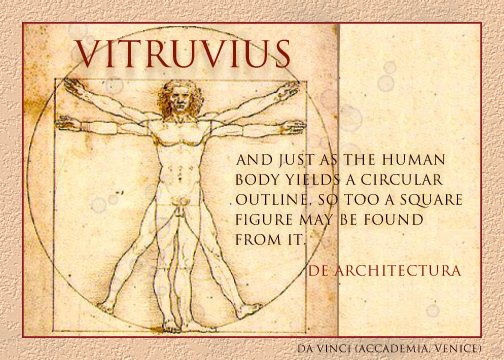 VITRUVIAN MAN IN THE GOLDEN RATIO
VITRUVIAN MAN IN THE GOLDEN RATIO
WALK
In the construction art signs are the renaissance and classicism: the development of the perspective, the discovery of the golden section and the influence of Vitruvius (geometric proportions in nature). On the basis of the architecture and façade stones, the developments (in Spinoza's work come back) informative. Major architects and builders are: Hans Vredeman de Vries (perspective), Henrdrik de Keijzer (natural palette and performances), Jacob van Campen (more ' geometric '), Philip Vingboons (classicistic and nature). See for a ovesight of Classicist architecture: ' Samozzi in Amsterdam ' (VVV Amsterdam)
Interesting locations are: Dam, Nes, Schouwburg, House Churches (Singel at the height of the Spui), Keizersgracht 123.
| NUMMERS | LOCATIES AMSTERDAM | ONDERWERPEN |
| 1 | Nes 45, Brakke Grond | Introduction |
| 2 | Beurspoortje/Rokin | Fair, book shops |
| 3 *∆ |
Dam, Paleis op de Dam, Nieuwe Kerk |
Political theatre,, Nieuwe Kerk, * ∆ Stadhuis |
| 1 *g, 16 |
Nes 45/Brakke Grond, Gelderse kade 16 |
Rhetoric chambers/theatre on the street/Vondel |
| 1 *g | Oude Zijds Voorburgwal 282-296/Nes 45 |
Determinism/~ g Descartes |
| 9 *ÏÏ |
Oude Zijds Voorburgwal 231 | Need of science |
| 10 *g |
Oude Zijds Voorburgwal 300 | Facade bricks/(money)morals |
| 6 *∆TT |
Begijnhof | Position non-Calvinists: Catholiecs |
| 7 | Spui/Singel 452 (tLam) en Singel 118 (de Zon) | Positin non-Calvinists: Lutherans, mennonites, socinians |
| 11 | Waterlooplein | Position non-Calviniss: sefardic Jews |
| 5 | Kalverstraat (nabij Begijnhof), Westermarkt 6 | Hidden scientists |
1a. INTRODUCTION TO WALKS AMSTERDAM SPINOZA (Brakke Grond, Nes 45)
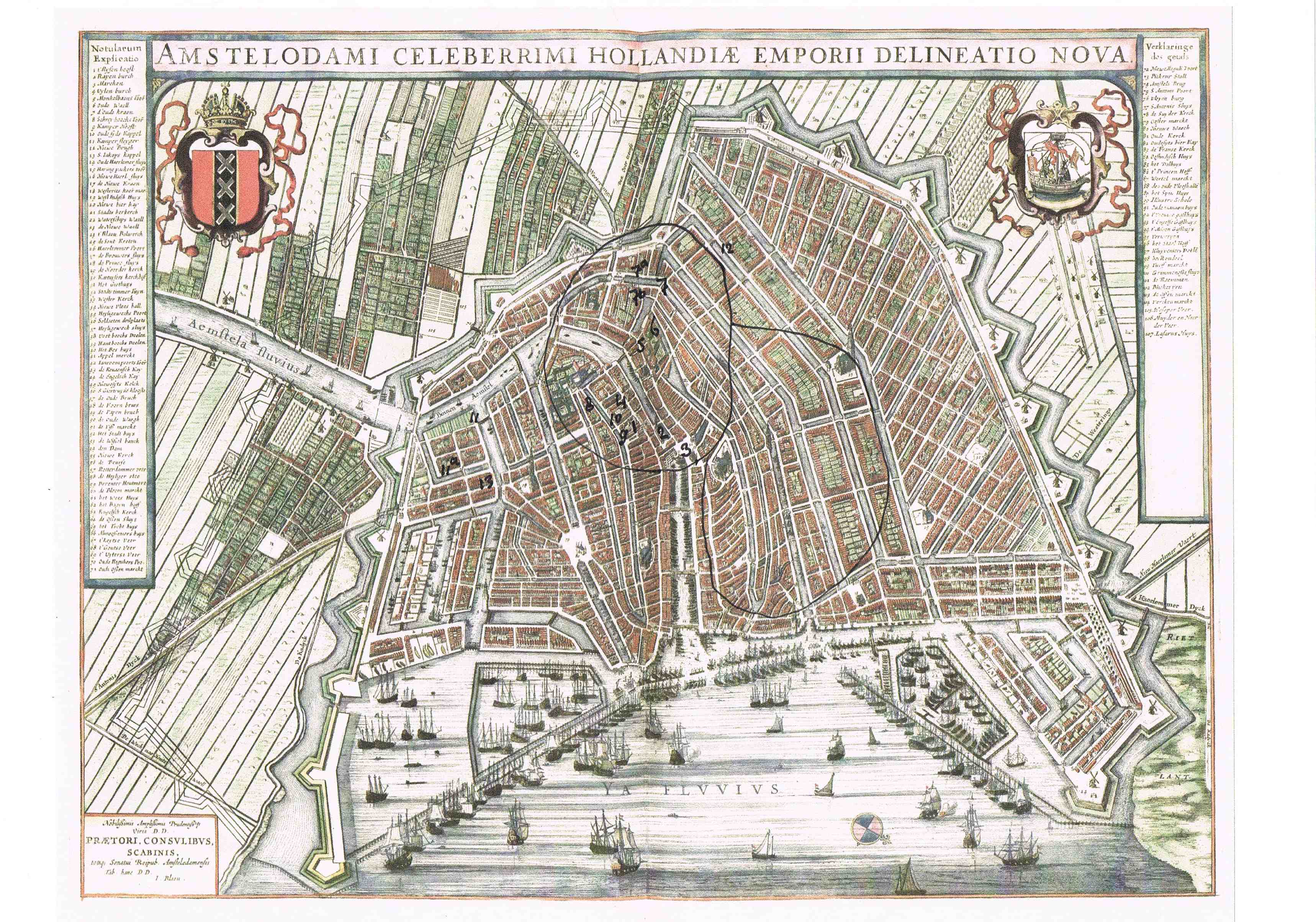
The walk ' Amsterdam Spinoza can start near the circled areas on the MAP FROM 1649 (left) South of the Dam along the spiritual ' beeldenstorm' (the non-violent 'storm' of changing ideas comparable to the, violent, storm that destroyed statues in catholic churches'), which took place in the 16th and 17th century in Amsterdam. Further along the Canal on the west side of Amsterdam. Old ideas were no longer obvious, such as about the existence of an afterlife in which one could be punished, or that man by the Fall would be bad of nature.
Spinoza (1632-1677) will between his 17th and 30th year, so roughly the period from 1649-1661, often will have been here in the Nes and its surroundings, first as a trader and later he must have lived somewhere here. Furthermore, he lived on the Singel and came in the Dirk van Hasselt steeg at his publisher Rieuwertsz. Influenced by what he saw and experienced in Amsterdam and from his conversations with friends and other contacts, whom he met here, he developed his theory.
On the walk is attention for the actualities of that period and the period before Spinoza and the ' visual representations ' in the art and architecture , the relative freedom in Amsterdam for people who were persecuted, the place of various churches elsewhere especially where it is relevant to understanding of Spinoza's work (see also the right-hand page; this provides connecting points on the route ' Singel 452 to the station ' to places to visitSpinoza or his friends, been where). Who were the "people of reason ', about who he writes in his Ethics ? Amsterdam in the period after the rise of the trade, the 'beeldenstorm', the 80-year-old war from 1650 until 1672 the change of flowering at the height to the invasion of the French in the Netherlands in the 'Disasteryear' 1672. A war that lasted until 1677 and after which the flowering period in the Netherlands was to an end.
Based on this web page different walks (also digitally) can be followed. In the page layout the initial location order at a first walk is released. At various points is a particular topic from his life or the Amsterdam background highlighted. The left of this web page outlines in particular the Amsterdam background; the right part put the spots on Spinoza, where he and his lots came and talked. And where they talked about. In the page layout does not follow the location order.
One can thus choose an own location order, depending on time and interest.On top stands (along with a drop on the right-hand page top) a walk that within the limits of 2 hours can be done, where his birth place and notes on his Jewish background is not included in the route.
The cultural development in the city can be read from the ornaments on homes and architecture. The following references are used:
* ÏÏ early Dutch Renaissance Hans Vredeman de Vries (1527-1606)
* g facade stone/image
* gb facade stonen/image (biblical)
* naturalistic ornament; Dutch renaissance; Hendrik de Keyzer (1565-1621)
* ∆ Dutch classicism; Jacob van Campen (1596-1657)
* ∆ TT Dutch classicism; Philip Vingboons (1607-1678)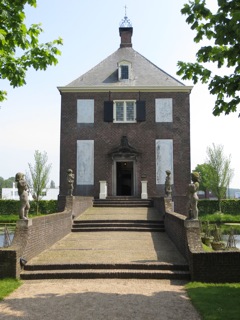 Out of the architectural designs speaks a strive for harmony. The in Italy discovered 'golden ratio' was recently applied. The discovery that mathematical ratios were often found throughout nature and are perceived by people as harmonious. Constantijn Huygens saw in that musical notes are formed by simple mathematical ratios. The Dutch classicism one can also to read good in ' Constantijn Huygens' 'HOFWIJCK ' (right), that Huygens designed together with Jacob van Campen influenced by Vitruvius.
Out of the architectural designs speaks a strive for harmony. The in Italy discovered 'golden ratio' was recently applied. The discovery that mathematical ratios were often found throughout nature and are perceived by people as harmonious. Constantijn Huygens saw in that musical notes are formed by simple mathematical ratios. The Dutch classicism one can also to read good in ' Constantijn Huygens' 'HOFWIJCK ' (right), that Huygens designed together with Jacob van Campen influenced by Vitruvius.  (see right Leonardo DA VINCI, 1452-1591, 'Vitruviusman' from 1590). The garden is an important part of the design. Also the current Bijbels Museum (Herengracht 364-370) from 1662 of Vingboons has a beautiful garden; inside is a odors Cabinet. The possibilities to discover Nature with microscope and telescope, lead Constantijn Huygens and many with him to the idea that God not only spoke to man through the Bible but also by the "Book of nature". Some other developments in thinking about God, nature and science at an international level expressed before 1648 in poems and engravings are here.
(see right Leonardo DA VINCI, 1452-1591, 'Vitruviusman' from 1590). The garden is an important part of the design. Also the current Bijbels Museum (Herengracht 364-370) from 1662 of Vingboons has a beautiful garden; inside is a odors Cabinet. The possibilities to discover Nature with microscope and telescope, lead Constantijn Huygens and many with him to the idea that God not only spoke to man through the Bible but also by the "Book of nature". Some other developments in thinking about God, nature and science at an international level expressed before 1648 in poems and engravings are here.
The title ' evolution of the mind ' refers to Jonathan Israel's book ' Revolution of mind; Radical enlightenment and the intellectual origins of modern democracy '. Unlike Israel, who focuses on the period during and long after Spinoza , this web page focuses on the evolution which had developed within the Netherlands (witin Amsterdam took a special stand) before and with Spinoza . The work of Spinoza is herin a scientific highlight. In Spinoza's own terms: the Amsterdam and the Republic after the Revolt (the Revolt from the Spanish, the 80-years War) were important work causes for Spinoza's work. Several scientists published pretty quickly after Spinoza's death work in his line, like the empiristic Enlightment philosopher John Locke, who also had lived in Amsterdam and was influenced by, inter alia, Hugo Grotius.
2. STOCK MARKET (Rokin/Beurspoortje near Dam)
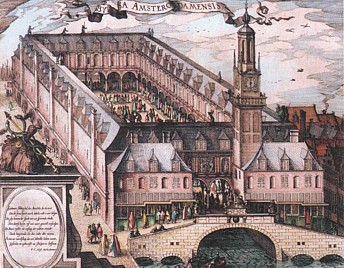 FAIR OF HENDRIK DE KEIJZER FROM 1611; SEEN FROM THE SOUTH; POSITIONED SOUTHSIDE OF THE DAM (ROKIN)
FAIR OF HENDRIK DE KEIJZER FROM 1611; SEEN FROM THE SOUTH; POSITIONED SOUTHSIDE OF THE DAM (ROKIN)
In the 16th century the Amsterdam trade had developed significantly . From 1611 stood on this spot already a big Fair, built by Hendrick de Keyser. The picture shows how lively it was around the fair. It is also shows that the Amstel flows here under the stock market.
The water, the trade, the stock market, are important links in the mental changes that took place. New ideas were also in other commercial cities with location on the water such as Antwerp, Bruges, Ghent, the Hanseatic cities, Venice.
The expansion of the overseas trade, the technique that was necessary, the opportunities to invest money and increase, all this brought immense changes, which went together with new ideas. For example, there came 'rules come about meetings at sea with ships of other countries.
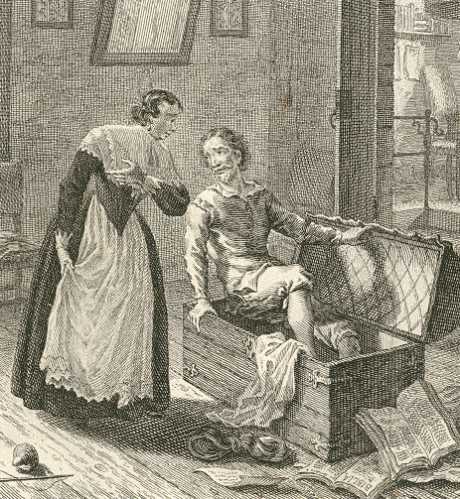
The jurist HUGO GROTIUS (1583-1645) (right, in books coffin) found that each ship should have right of passage, so that no trade was hindered. He develops a natural philosophy, which people and peoples of what religion or nationality for those reasons should make appointments about equal rights.
On the South side of the stock exchange are book shops. Books were a major commercial product for Amsterdam. Spinoza's publisher was Jan Rieuwertsz (1617-1687), who is also the publisher of the Dutch translation of Descartes. Click here for the exact locations of Stock market and Dam around 1630.
In Amsterdam is the most important part of the trade in the first half of the 17th century focused on the countries on the Baltic Sea, the Nordic trade. It has an important position in the trade because the traders have a name of reliability (information in the House of the grain inspectors in the N.Z. Kolk). The Witsenfamily (probably neighbours of Van den Enden), who later will deliver many mayors, were grain traders. Arms dealer Louis De Geer (1587-1652) is to a high degree involved in the struggle for the Reformed cause (with which Dutch Oranges had many bounds), among other things, in the 30-year-old war, has excellent contacts with Sweden and is strong internationally-oriented. In 1602 the Dutch East India Company is founded.
1b. RHETORIC CHAMBERS (Nes 45; Gelderse kade 16)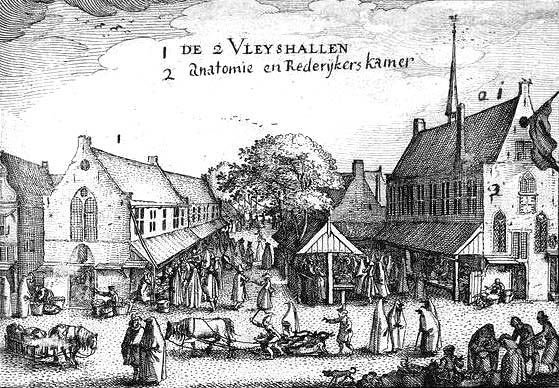
NES MEAT HALLS; ANATOMY;
RHETORIC CHAMBERS d'EGLANTIER ‘IN LIEFDE BLOEIENDE’AND 'WIT LAVENDEL'
In the Nes above the meat halls in the former Margaret monastery (right) came rhetoricians. The Eglantier existed from 1518. Rhetorics chambers were originally religious brotherhoods that enhanced ecclesiastical holidays with mystery-games, processions and tableau-vivants. 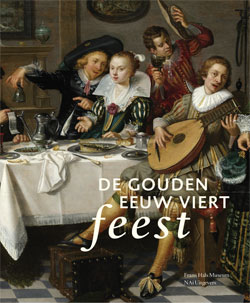
They have, inter alia, by their public street theatre a broad public. The rhetorics chambers in de Nederlanden did exchange mutual . It was often cheerful, as shown (right) on ornate paintings of FRANS HALS (1587-1666) from Haarlem, where the rhetrorics chamber "Trou must blyken ' was active. The Eglantier knew prominent members with poets as L.J. Spieghel (1549-1612), Roemer Visser (1547-1620), Bredero (1585-1618) and Hooft (1581-1647), who often also had political influence. In their poems and theatre pieces develops a new own ethics apart from a reference to a particular God. They often use
symbols from nature. They often come together in the house of Roemer Visscher (Gelderse kade 16) en lateron to Hooft op het Muiderslot.

COORNHERT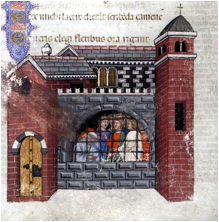 What around 1600 is conducted is often ' Ethics ' and is about the question ' How should I live in this changing time? '. Dirck Volkertsz Coornhert (1522-1590), member of "de Eglantier", wrote long before Spinoza in 1585 the first Dutch Ethica ' Zedekunst dat is wellevenskonste '. On the advice of his friend Spieghel he does not refer to God, although in Coornhert's own life the divine played an important role. Another important contribution of Dirck Volckertszoon Coornhert was the translation into Dutch of Latin works as of Seneca (-4-65) and Cicero (-106--43). In addition to this work on ethics from the Roman period he translated Boëthius ' Consolation of philosophy '. BOËTHIUS (480-525) wrote this book about the consolation of thinking from the prison (right). Dirck Volckertszoon Coornhert-himself calls the human thinking a ' vonxcen (spark) of the divine light '. Such well-chosen book translations contributed to the independent thinking in their own language , what could be spread among many provided by the not long ago developed techniques of bookprinting press. Dirck Volckertszoon Coornhert wrote in the form of conversations with friends such as Spiegel about ' the highest good ', about what is the most important thing in life.
What around 1600 is conducted is often ' Ethics ' and is about the question ' How should I live in this changing time? '. Dirck Volkertsz Coornhert (1522-1590), member of "de Eglantier", wrote long before Spinoza in 1585 the first Dutch Ethica ' Zedekunst dat is wellevenskonste '. On the advice of his friend Spieghel he does not refer to God, although in Coornhert's own life the divine played an important role. Another important contribution of Dirck Volckertszoon Coornhert was the translation into Dutch of Latin works as of Seneca (-4-65) and Cicero (-106--43). In addition to this work on ethics from the Roman period he translated Boëthius ' Consolation of philosophy '. BOËTHIUS (480-525) wrote this book about the consolation of thinking from the prison (right). Dirck Volckertszoon Coornhert-himself calls the human thinking a ' vonxcen (spark) of the divine light '. Such well-chosen book translations contributed to the independent thinking in their own language , what could be spread among many provided by the not long ago developed techniques of bookprinting press. Dirck Volckertszoon Coornhert wrote in the form of conversations with friends such as Spiegel about ' the highest good ', about what is the most important thing in life.
Within the theological controversies of his time, Dirck Volckertszoon Coornhert opposes Beza (1519-1605) and Calvin (1509-1564) on the predestination. This would mean that evil comes from God and would take away every motive to do well. This he argues in the line of Castellio (1515-1563), Franck (1499-1543) and Schwenkfeld (1489-1561). This way he advocates freedom of conscience, full freedom of religion and promotion of peace of religion.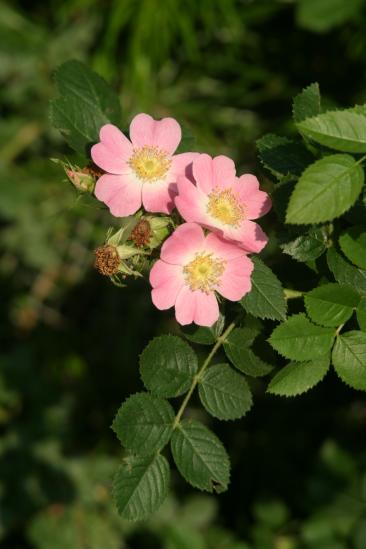
The blazon of the EGLANTIER (right), a rose, is by the graphic artist Dirck Volckertszoon Coornhert placed in its environment. The rose is visited by a bee, that the honey (love) spreads and is attacked by the parasitic Spider (danger!); the Rose has thorns developed. Spinoza's seal seems remarkably strong in the blazon of "de eglantier". Espinoza means ' thorn '. in his seal Spinoza used the same rose in conjunction with this ' defence-weapon ': a thorn and his device ' CAUTE ', ' BEWARE '. The appearance of the eglantine appears on the seal on the crucified on the blazon (see top). Next to each other the coat of arms and the seal form a (possibly accidental) illustration of the transition from religious thinking to natural philosophy and of Spinoza's equating God with nature. These two ways of thinking in the seventeenth century continued to coexist.
Natural ingeneer Simon Stevin(1548-1620) says in his book 'Het burgerlijck leven' (1590) that men of science may no longer believe in God, but they should behave and look if they do, while women and children should be encouraged in faith. In the beginning of the 17th century housed next to d'Egelantier the rhetoric chamber "Wit lavendel (White Lavender)" in the Nes/Brakke Grond (built in 1654). Of this chamner Vondel was a member. Bredero (member of "de Eglantier") is born on this spot (see wall-stone) and grew up here. Vondel grew up in the nearby Warmoesstraat . At a later age, he got a job at the Bank of Loann in the vicinity (Nes 57).
10. FACADE STONES/ (MONEY)MORALS (Oude Zijds Voorburgwal 300)
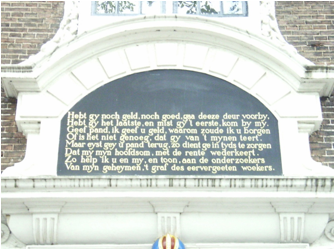
GABLE STONE ABOVE ENTRANCE CITY BANK OF LOAN: PRINCIPAL SUM Back with INTEREST
Suddenly people got financially successfull. How to deal with this new situation? New ideas were disseminated not only through the churches and theatre plays. At various places in the city witness the rhymes to the walls of a new morality. On the facade stone above the entrance of the Bank of LOAN is written that things of value can be loaned but must payed back with INTEREST (left).
The protestant ethics allowed profit making contraty to the catholic morals.
 GABLE STONE ABOVE SIDE ENTRANCE CITY BANK OF LOAN
GABLE STONE ABOVE SIDE ENTRANCE CITY BANK OF LOAN
There is still however a side entrance where the ' needy ' could pledge his stuff for a small amount .
Coornhert (see Schama) had put his ideas about wealth in the ' Comedy of the Rijckman '. The tenor in his financial ethics: wealth-itself is not wrong, only a wrong use of it. Coornhert's ethics is that of ' enough '. Towards the way of life of a character ' Need ' a lot ' he proposes ethics 'of enough '. This way of looking at money, is quite common in that time. What money is left after the ' enough ', goes to charities, for example to a court for the elderly '. Or it is spent on contracts to painters. It is known that De Geer as ' mercator sapiens ,( a merchant that money spents on sciences), became a patron of the Czech educator Comenius (1592-1670). This is also in line with Calvin.
Another well-known play (1617) with ' money'morals is ' Warenar ' of P.C. Hooft and S. Coster. Warenar is in fact not a Curmudgeon, but a tragicomic figure, whogets completely startled by an unexpected find , and gets totally mesmerized by this treasure. But at the end he is able to let go the treasure and give it away: so it was not avarice but obsession that kept him bound.
9. NEED FOR SCIENCE (Atheneum illustre; Oude Zijds Voorburgwal 231)
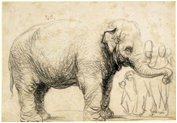
AN ELEPHANT ON THE DAM (REMBRANDT 1638)
In Amsterdam the sciences thrived as a result of the trade. There were created maps ; ship equipment was developed. People took a lot of things from distant regions. On Kloveniersburgwal 87-89 Blue-Jan shows his collection. Hansken is a born on Ceylon elephant which is brought to Amsterdam in 1633 with a ship of the United East India Company , and is shown on the Dam.
There arises a need for an Amsterdam University. By the existing universities is not, however, allowed a full University in Amsterdam. In 1632 is opened one on a limited scale, the Athenaeum Illustre University. A training for a study in Leiden. There were the exams were done. So the control on science maintains with Leiden professors as Gomarus (1563-1641). And Revius (1586–1658), one of the fiercest advocates of heretic persecution. He had a predecessor had in Lipsius (1547-1606): ' man must accept his destiny '. The killing of heretics in his eyes was inevitable. ' Burn evil to keep away the whole '. Gomarus was the opponent of Arminius (1560-1609).
Arminius was initially quite strict in the learnings. When he tried to refute the views of the liberal Dirck Volckertszoon Coornhert and deepened his ideas, he was grabbed by his tolerance-ideal. 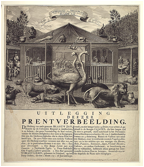
He became one of the most tolerant religious leaders of our country and had particularly among intellectuls many supporters. Although the population on the large was on the hand was of Gomarus, most intellectuals were Arminians.
Constantijn Huygens (1596-1687) had a high position at the Court of Frederick Hendrik. This way he could put a large weight on his art collection and he could also finance Vossius and Barlaeus. At the opening Barlaeus (1584-1648) talked (he talked about moderation of the desire for money), the arminian Vossius (1577-1649) (in his lecture that science gives the cause of everything) and Hugo de Groot (Grotius) were present. Also spoke Hortensius (1605-1639), which stood in contact with the Bredaase Beeckmans (1588-1637), the mathematician who influenced Descartes .
It was at least something, but people like Coster and Bredero, Hooft would have preferred to have had a University with Dutch as language.
(top right) Collection of BLUE-JAN (Kloveniersburgwal)
1. DETERMINISM/DESCARTES (Oude Zijds Voorburgwal 282-296/ Nes 45. Brakke Grond)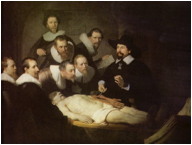
ANATOMIC LESSON OF NICOLAAS TULP (REMBRANDT, 1632)
At that time (Flemish) doctors operated there in the buildings to the Nes now and then . Rembrandt painted "the anatomy lesson of Nicolaas Tulp (1593-1674) '. It shows the at that time increased interest in the body.
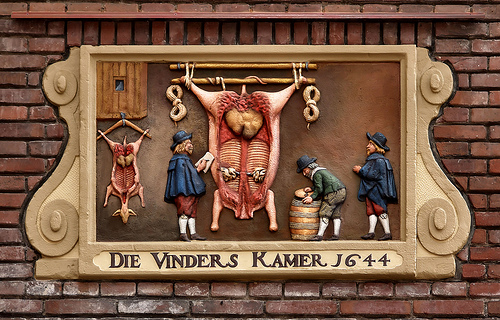
On the ground floor there were here meat halls. The presence of the Guild of meat inspectors (' The Finders room ', right) shows a façade stone on the Nespleintje. It is known that DESCARTES (1590-1650) likes to look around and study in meat shops. In doing so, he discovered that the heart is not a mystical body, but a kind of pump which works according to logical laws of cause and effect. The functioning of the heart is a well known example in the explanation of his scientific method (in ' Discours de la methode ' from 1637), which aims to expose the laws of cause and effect. His method laid the basis for the contemporary scientific activities. Descartes was initially very controversial at the universities. The Cartesian philosophy was the basis for ' mechanization ' of the world view and is based on the rationale that all human knowledge one systematic, organized hierarchically, construction work.
3. POLITICAL POWER IN AMSTERDAM (Dam) 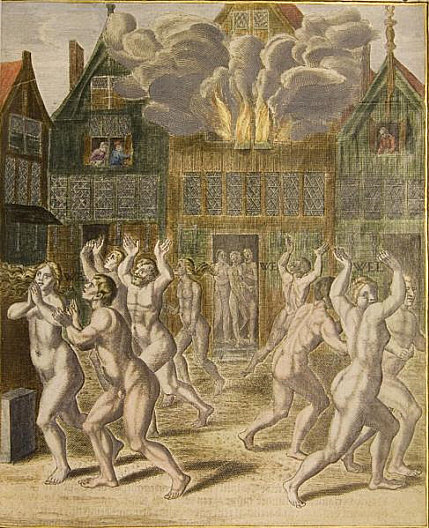
The Dam formed by the years an important stage for real political power and indicated.
ANABAPTISM UPRISING on the DAM 1535
Already in 1535 was the Dam been onstage for a revolt of the ' WEDERDOPERS ' (engraving by Claes Jansz fisherman, left). They held a demonstration by walking nudely . This way they expressed their ideal of equality of all people. This peaceful demonstration was harshly suppressed by the police. Executions followed.
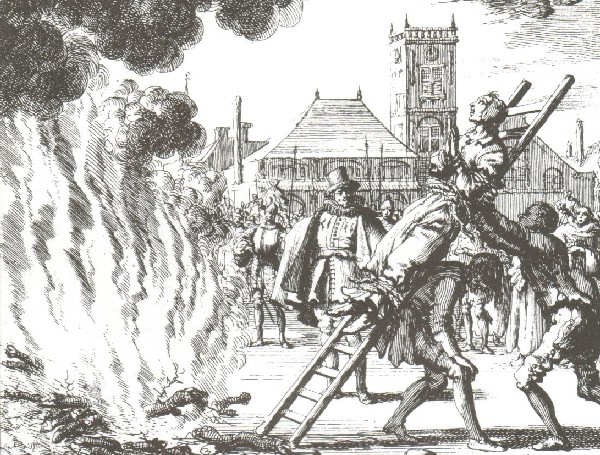
The Mennonite ANNEKEN HENDRIKS (right) in 1571 was executed on the Dam. She was thrown into the fire with gunpowder in the mouth. BY this way of penalties, the Authority wanted to make clear to the public what was not allowed and what could happen when forbidden were violated.
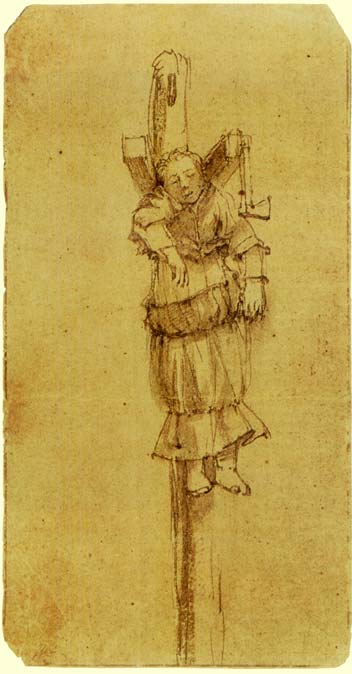
Dirck Volckertszoon Coornhert lived around the corner In 1535 in the Warmoesstraat 111. He then was 13 years old. Such scenes laid possibly a basis for his later fight against killing heretics. And for his ideas about reform of criminal law and criminal practice, also for other lawbreakers than conscientious objectors and political prisoners.
From the City Hall was spoken justice. To the public hanging on the Dam many people came to watchi. Rembrandt made in 1664 a drawing of Elsje Christiaans.
ELSJE CHRISTIAANS (left).
after the execution It was to see on the Galgenveld in North, along with the cause of her execution: the axe with which she had killed someone.
ALTERATION
Although there existed freedom of religion in the Republic, the reformed Calvinist Church was since the ALTERATION (under) in 1578 the official Church in Amsterdam. The official Church had, inter alia, the task of care of services for everyone, like a marriage and funerals. In Amsterdam a rebellion on the Dam had preceded the alteration. Since then were here on the Dam in the from origin Catholic Church ('Nieuwe Kerk') reformed services were held. The merits of the Calvinists in the rebellion and war against the Spaniards had made them claim that special position.In fact, Amsterdam, where lived a lot of Catholics, had not wanted this, just as William the Silent and D.V. Coornhert. Fanatic, sometimes cruel, calvinist 'geuzen'-troops under Lumey had spilt more blood than only of Spanish troops and sometimes more than was necessary for a victory.
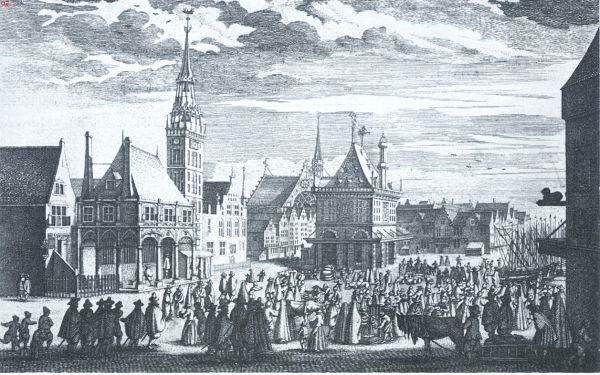
ICONOCLASTM
After the iconoclasm of 1566 are the Church Interiors gradually sobered up.
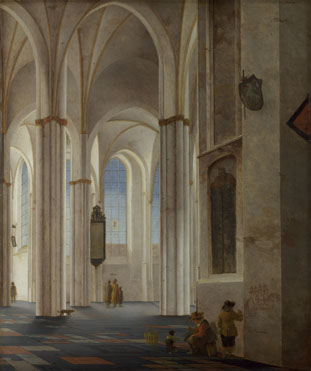
Pieter SAENREDAM'S (right) 'Buurkerk' church shows a high area of light, as it were, a celestial Dome, in which man scratches his experiences on the wall. Services are held in the Dutch. The Bible is read in Dutch. And to the own time interpreted.
Also the synagogue of the Portuguese Jews, which is built in 1667, is made in this style. The Interior of the synagogue resembles the austere Protestant churches with a starring role for the light.
Outside the church the Calvinists could spread moral ideas hrough gable stones. An example is the stone with a ' vermaan' rhyme on the changing fate.
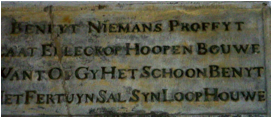 'VERMAAN' (ADMONISH) RHYME ABOUT THE CHANGING FATE (Pentagon)
'VERMAAN' (ADMONISH) RHYME ABOUT THE CHANGING FATE (Pentagon)
BENYT NIEMANS PROFFYT
LÁÁT ELLECK OP HOOPEN BOUWE
WANT OF GY HET SCHOON BENYT
HET FERTUYN SAL SYN LOOP HOUWE
6. POSITION OF NON-CALVINISTS: CATHOLICS (Begijnhof; R.K. Chapel, ∆TT)
For non-reformed believers was needed to adapt to the rule: ' there is freedom of religion, but you should not do services openly '. E.g., no chimes. Only Calvinist clock pealing was allowed. At the Begijnhof one can see that houses from outside look like homes, but inside are furnished as church. The Catholic Philip Vingboons designed the Catholic home chapel in 1671
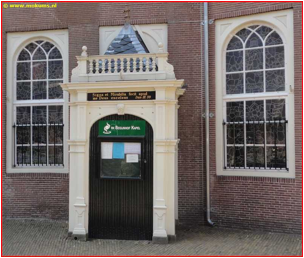
(left) OUTSIDE R.K. CHAPEL BEGIJNHOF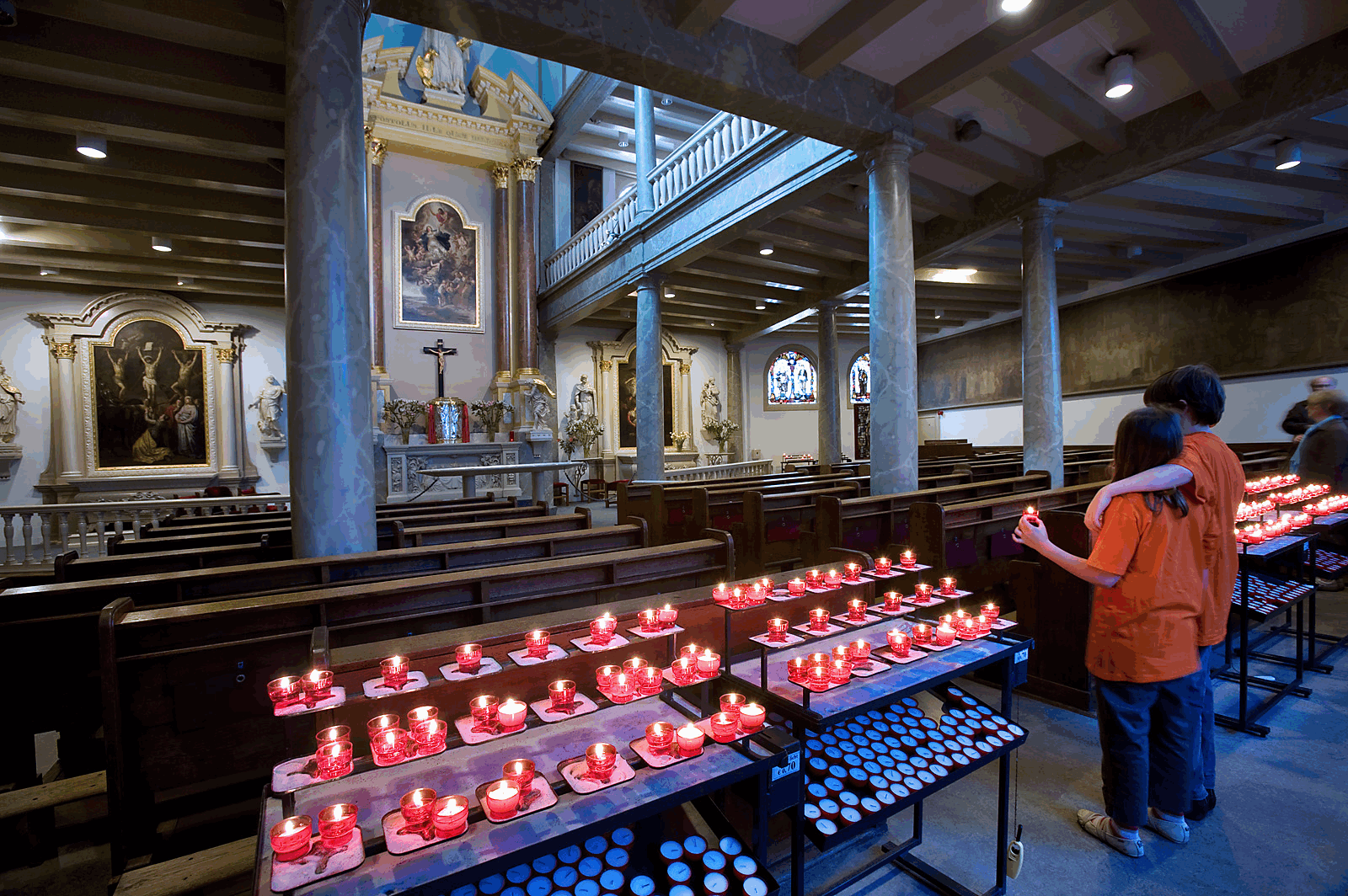
INTERIOR (right)
In 1579 is much Catholic possession passed to the Calvinists. The transfered churches were gradually ceded to different religious groups, who stayed in Amsterdam. The former Catholic Church, opposite the hiding Catholic Chapel, became an English Church in 1607 . There came the Pilgrim Fathers among others. A painful situation for the Catholic believers.
On the spot of the current Moses and Aäronkerk (Waterlooplein 207/Jodenbreestraat) stood from 1640 a Franciscan House Church.
7. POSITION OF NON-CALVINISTS: MENNONITES; LUTHERANS (Spui/Singel)
The Church played an important role at this time. For various reasons in Europe were new denominations, which no longer felt at home in the Catholic Church. Luther had opposed the trade in indulgences of the Roman Catholic Church. Furthermore, there had been a process of gradually loosing dogmatic ideas. This led to a series of new denominations such as Mennonites, Lutheranians, Remonstrants.
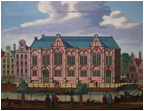
7b. SIDE OF LUTHERANIAN CHURCH/ SPUI
At Singel 411 stands a Lutheran Church from 1633. The Spui-side still shows that the services before 1633 in took place 7 contracted homes. The timber trade with the northern countries in this period was still very important. Intervention of the for Hanseatic trade important Danish King, has achieved that the Lutheran Church got this the more official status in Amsterdam.
7c.MENNONITITE COMMUNITY (Singel )
SINGEL 452 FRONT (left) 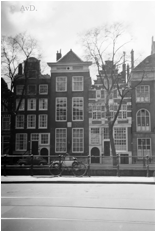
Moments later one sees on the other side the Flemish-Mennonite Church 'Near the Lamb' (on Singel 460). The front looks like an ordinary House. On the facade a ' normal ' reference of a lamb refering to the adjacent former brewery and pub 't Lam '. To the rear (right) is the nicer, actual entrance of the Mennonite Church. Within a sober Interior without images.
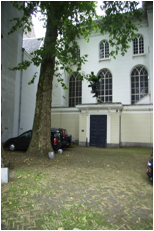 Mennonite churches were sometimes not churches but shelters ' 'Vermaninghe'/Admonitions '. Within the Mennonites plenty of currents are to distinguish. Much information stands on www.gameo.org/encyclopedia. Further north on the Singel sat ' Waterlanders ' and ' the Sun ' . In general, they were of an Apostolic Christianity: Christ as an example and inspiration for a 'virtuous' life. From its members was asked an active choice for the faith by baptizing on an adult age .
Mennonite churches were sometimes not churches but shelters ' 'Vermaninghe'/Admonitions '. Within the Mennonites plenty of currents are to distinguish. Much information stands on www.gameo.org/encyclopedia. Further north on the Singel sat ' Waterlanders ' and ' the Sun ' . In general, they were of an Apostolic Christianity: Christ as an example and inspiration for a 'virtuous' life. From its members was asked an active choice for the faith by baptizing on an adult age .
Mutual there was pretty much squabbling between these three currents. As regards in dealings with the world around them the Waterlanders were the most mondane and outside-directed and had of the three Mennonite currents most wellknown members. They mainly based on their own interpretation of the New Testament and did not ban members soon (also the Mennonites as the Sefardics banned sometimes members).
The well-known poet Vondel, a Mennonite from home and deacon at the 'Waterlanders' (1616-1620), which was then located in the Oude Nieuwstraat, came into conflict with them. He wanted to remain faithful to the Bible, not so much to the inner conviction. When he got enough of the differences he joined the Roman Catholic Church The Krijtberg (Singel 448).
The Waterlanders and the Sun were to the North: the Waterlanders/ ' In den Toren ", i.e. at the bridge made by Leeghwater (also a Mennonite) Singel 159. The entrance to the Sun is seen at Herengracht 109-111 (above the gate is a small relief of a Sun). What Mennonites had in common was that they are preferably settled in ' right'side of the city (seen from the North): the Western ' Nieuwe Zijds '. This initially had a religious basis; moreover, was the former property of the Catholics in the form of monasteries, mostly located on the East side of Amsterdam.
7d. SOCIANISM
In principle there was freedom of religion, although not all religions could be professed publicly. Also the many immigrants could profess their religion. On order of the Church Council in 1648 and later by the States the socianism was forbidden. Socinus (1535-1604) taught that only the New Testament had to be recognised as a source of intellectually explainable revelation; that there was one God, not three; that there existed no original sin and no predestination. Christ was not Savior by the cross death but by his moral example. Later, these were called unitarians, who included for a long time a considerable group of faithful Christians (Jon Israel, 2010, ho V).
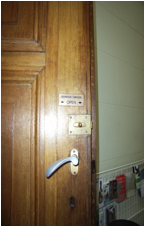
In the Mennonite Church 'Near the Lamb' socinian church services were held, witness the awkward door button (you had to go up instead of down), which is made at the entrance to the Church room to incident police men to slow down, so that in timeto a Lutheran service could be switched.
AKWARD DOOR BUTTON
A pastor with socinian ideas was Galenus Abrahamsz de Haan (1622-1706). Hej also spoke in public on the Rokin like other collegiants-leader Adam Boreel. In J. Lindeboom 'Stiefkinderen van het Christendom' are many currents and their connections to several persons mentioned on this website with explanation.
A related movement with the socinianism was that of the sacrementarians, who rejected the real presence of Christ in the sacrament of the supper. David Joris (1501-1556) had previously sympathised with this flow. Later within the Liberal Church history of the 19th and 20th centuries this sacrementarians are seen as exponents of the reasonable, elastic Protestant folk tradition that supposedly reflected the Dutch nature .
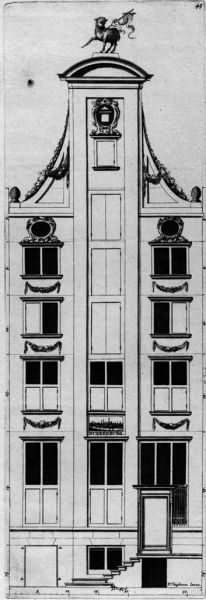 7e. the LAMB, SYMBOL OF THE BOHEMIAN BROTHERHOOD (Singel 460)
7e. the LAMB, SYMBOL OF THE BOHEMIAN BROTHERHOOD (Singel 460)
The lamb on the Mennonite home church 'Near the Lamb', Singel 452, refered to the initially adjacent café 't Lam (location the current Odeon). On top stood for a long time (at least until 1817; from at least 1648) a sheep with the FLAG, symbol of the Bohemian brotherhood, and later that of the Moravian School of the Moravian community. Already before the current building built in 1663 by Vingboons for Gillis Marcellis was built, stood this symbol on the Cafe/brewery, as can be seen on Van der Helst ' Shooters meal ' from 1648 on the occasion of the peace of Münster. Comenius was connected with the Bohemian brotherhood, where he has been a priest for some time.
In Amsterdam there is interest in the work of the ancient Egyptian way Hermes Trismegistus, a related current. Ficino and Paracelsus are in the late Middle Ages, important in the further development and dissemination of these ideas. In 1614-1616 appears three Rosicrucian manifests. Herefore is In the first half of the 17th century in Amsterdam in various circles interest, including in Rhetoric circle (Roemer Visscher). Lateron Comenius ' ideas go more and more in the direction of eocumenism. The owner of brewery 't Lam was also owner of the adjacent buildings in which the Flemish-Mennonite House Church 't Lam and the Catholic House Church de Krijtberg were housed : in total an real oecomenic angle.
7f. SYNAGOGUE and school of TALMUD TORA ( Waterlooplein 133/156, 'De Herschepping' and next to Mozes en Aäronkerk, 205)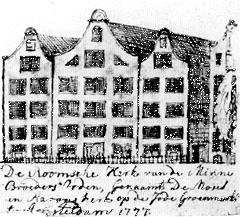
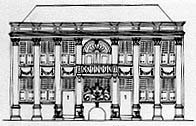 The sefardic Jews had until 1639 HOUSE-SYNAGOGUES (links). These unite in one synagogue location Waterlooplein 205.
The sefardic Jews had until 1639 HOUSE-SYNAGOGUES (links). These unite in one synagogue location Waterlooplein 205.
In one of the adjoining houses would Spinoza are born (also called as place of birth is Zwanenburgwal 15).
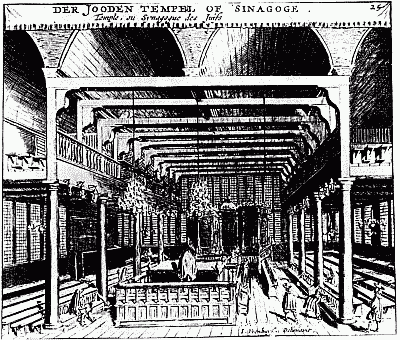
In 1639 on the Houtgracht (now Waterlooplein 133/156) the synagogue built in Classicist style of the society the TALMUD TORA (right) is opened. See also the Interior (right). On the Houtgracht stands next to the synagogue the school where Spinoza got lessons and which he visited untill his 15th year .
7g. WALLOON CHURCH (30. Walenpleintje 159; naast Oude Zijds Achterburgwal 155)
In 1578 came here a Walloon Church for Huguenots, French followers of Calvin. After been at first chased in France, they were lateron protected by the Edict of Nantes. Louis XIV raised this Edict in 1685. This led to a large influx of Huguenots in the Netherlands including Amsterdam. There are several other Walloon churches built in Amsterdam. Orange was often strongly linked with the Walloon Church. Stadtholder William III was baptized in a Walloon Church .
7h. The REMONSTRANT HOMECHURCH 'RED HEAD'
In the thirties the remonstrants got a home church on Keizersgracht 108 (with a façade stone ' RED HAT ')
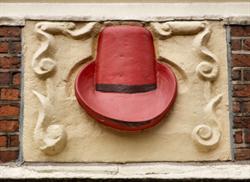 The remonstrants, successors of Arminianism, had a lot of support in this part of Amsterdam. Put Their opponents putted except Arminius and Wttenbogaert, also the Anabaptist David Joris and Dirck Volckertszoon Coornhert on the ' Arminaense Dreckwagen '. And Johan van Oldenbarneveldt assigns them the way. The remonstrant Pastor Johannes Wttenbogaert (1557-1644) is the successor of Arminius. Wttenbogaert was supported by the family Reaal. Laurens Reaal (1583-1637) had exceptional ideas, even exceptonal in the remonstrant circle: he stands for letting the natives benefit of the exceptional revenues of VOC and WIC-Trade Commission .
The remonstrants, successors of Arminianism, had a lot of support in this part of Amsterdam. Put Their opponents putted except Arminius and Wttenbogaert, also the Anabaptist David Joris and Dirck Volckertszoon Coornhert on the ' Arminaense Dreckwagen '. And Johan van Oldenbarneveldt assigns them the way. The remonstrant Pastor Johannes Wttenbogaert (1557-1644) is the successor of Arminius. Wttenbogaert was supported by the family Reaal. Laurens Reaal (1583-1637) had exceptional ideas, even exceptonal in the remonstrant circle: he stands for letting the natives benefit of the exceptional revenues of VOC and WIC-Trade Commission .
1.c. POLITICS AND RHETORICS (Dam/ Brakke Grond, Nes 45; geometry school of S.H. Cardinael in Nieuwe Nieuwstraat 20)
Gradually the rhetoricians-pieces get a more mundane form and poetry and rhetoric -in classical rhetoric way- was practiced. Pieces of religious or moralistic content are now interspersed with mythological and heroic stories. This general trend is also been seen at the 'Egelantier' and 'White Lavender'. Lyricist and mayors sonP. C. Hooft had a great influence on the new development in the theatrical art, in which the classical drama got a large role. For example a piece of Terentius (-195 to-159) was transformed by Bredero (1585-1618) to his ' Moortje ' (1614). In this Renaissance comedy Bredero followed the classical piece, adapting it to the circumstances that he knew. Some, such as Joost van den Vondel (1587-1679), wanted to overtake the classic tragedy and surpass the writers. For Vondel this meant to transform Biblical substance in the form of a classical tragedy.
There was sufficient material for drama and tragedy to find in their own country.
Many struggles, war and iconoclastic had happened in the preceding centuries. Many were executed or exiled with dissent. Many famous scholars, writers and statesmen are jailed or killed. Or should have been absconding, or were ,reviled like on the cartoon 'd'Arminiaanse Dreckwagen' 'Arminian Shitwagon'.
For example, Prince William of Orange (1533-1584), who in 1582 was declared outlaw after the Dutch 'ACTE VAN VERLATINGHE', the Declaration of independence (right) on 26-06-1581 and was assassinated in 1584 after an amount of money which was put on his head. Also Dirck Volckertszoon Coornhert (1522-1580) was in prison and had to submerge at collegiants. Many, who are killed or imprisoned because of their opinions, are anonymous. As the "Rebaptizers" sfter their rebellion in 1535 in Amsterdam. The ' Revolt ' against the Spaniards took many lives.
The statesman Van Oldenbarnevelt (1547-1614) was in 1618 at the Binnenhof was beheaded because he wanted to protect the freedom of expression of Arminianism. His Secretary Hugo Grotius was jailed in castle Loevestijn. This played a role that some wanted to continue war (Maurits), like Van Oldenbarneveldt, were in favour of peace. This last had resulted in the 12-year-old ceas-fire (1609-1621).
In the controversy between Gomarists (' camp Calvinists ') and Arminianists (' camp Anabaptists of the Dreckwagen ') played the issue of free will. Maurits wanted to preserve the unity of religion before everything, although Arminius had been his own Pastor.
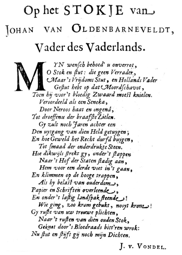 VONDEL ABOUT VAN OLDENBARNEVELDT
VONDEL ABOUT VAN OLDENBARNEVELDT
he rhetoricians dealt with these political experiences in their work. Through art criticism could be expressed. Vondel wrote (long time forbidden) poems and plays about this. Known is his ' Stick of Oldenbarneveldt '. He chooses party for those who defended freedom of expression. Although the allusions of Oldebarneveldt were discovered, it was covered and had the States wanted to condemn Vondel. Amsterdam foreclosed this however.
In other poems let him see the sadness that war entails. The poems are about the mothers, that mourning for their sons and husbands.
In 1617 by Samuel Coster de Nederduytsche academie was founded as a Chamber of rhetoric, escutcheon with a bee hive under an Eglantine, and the motto ' Zeal '. This dedicated itself mainly to the provision of higher education in the vernacular. Pitch was the later Theatre on the Keizersgracht. The Calvinist consistory did not like the creation. They urged the Amsterdam City Government, the 'Vroedschap', to make it close. There was objection to the two Mennonite professors, including the mathematician Sybrandt Hansz. Cardinael. This had a school from 1605 in the new Nieuwstraat 20. Also the contents of the theatre pieces they did not like. The educational institution was in 1618 closed and the performance of pieces ceased in 1622. Vondel's ' Vraghe of d'Amsterdamsche Academi to all poets and poets ' (1631) lead to vehement responses of the Calvinists. However in 1632 ' the ' Athenaeum Illustre could be opened.
2b THEATRE PLAYS ON THE STREET (Rokin/Beurspoortje)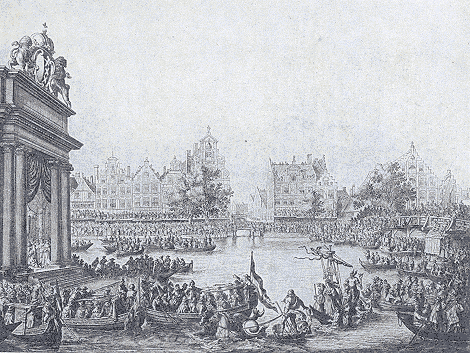
TABLEAU VIVANT AT THE VISIT OF MARIA DE MEDICIS (1638)
Scenes at markets and squares dit the rhetoric chambers traditionally. Was the work of Dirck Volckertszoon Coornhert especially focused on finding the highest happiness in themselves and on the passing of experience to a next generation, on mild legislation and manners, based on knowledge ('know or rest '), on criminal justice innovation and against the killing of people with differing opinions as hereticsin the 17th century, gradually increased the number of pieces , which had a political information function for the people. Also the range of the performances became wider.
MARIA DE MEDICIS 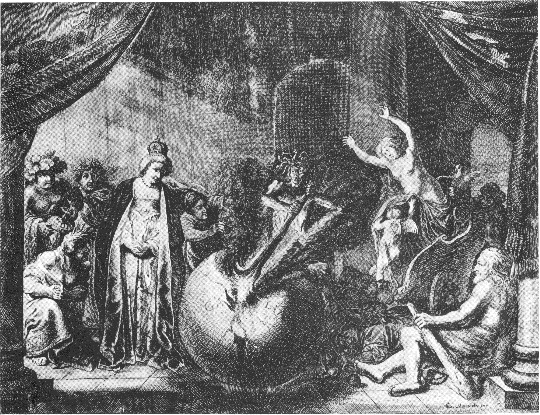 IN A SCENE
IN A SCENE
In command of the Government 'd'Egllantier ' played during the 12-year ceasefire with Spain from 1609-1621 applicable stories from Roman history. In the tyranny of the last Roman King Tarquinius, the attainder of LUCRETIA (in right column, painted by Rembrandt) and the foiled conspiracy of Brutus could the audience recognize allusions to the own history of the eighty years war. This kind of festivities were usually in a furious pace-about ten days-to be prepared by the Director of the whole Samuel Coster.
Absolute highlight of such theatre festivals was the visit of France's Queen Mother Marie de Medici in 1638 to the Republic. It was seenas an informal French recognition of the Dutch Republic. The reception was generous . MARIA DE MEDICIS (top right), the other guests, the mayors of the city, they drove all in their barques on the water of the Rokin, where Neptune bobbed to meet Maria and the cities virgin ('stedenmaagd ') and the god of trade Mercury greeted her . This kind of theatre is to see until the end of the 1950s. This is then in other form continued in theater pieces that were performed in the theatre on the Keizersgracht.
On Keizersgracht 384, where first the ' First Nederduytsche Academy was housed in 1637, a new ' Schouwburg of van Campen was built. In 1665, the Baroque theatre was replaced by a new one, which made more theatrical stunts possible. Directors as Vondel are pushed aside.
In 1669 a new Board was installed under the leadership of the company NIL. 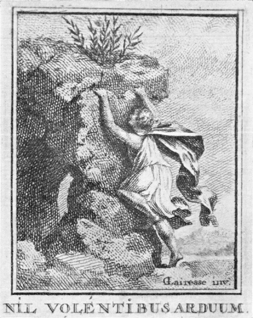 This has a more general new orientation of the Baroque theatre to performances in: on ' rational-classical ' bedrock Theatre according to the NIL VOLENTIBUS ARDUUM ideas of NIL = " nothing IS DIFFICULT for THOSE WHO WANT to ' (right; ' climbing to the laurel branch ").
This has a more general new orientation of the Baroque theatre to performances in: on ' rational-classical ' bedrock Theatre according to the NIL VOLENTIBUS ARDUUM ideas of NIL = " nothing IS DIFFICULT for THOSE WHO WANT to ' (right; ' climbing to the laurel branch ").
Lodewijk Meyer (1629-1681) who was from 1665-1669 Director of the theatre-old style, but gets disagreement with the leadership about the ' occasional Spanish repertoire ', is the founder of NIL in 1669.
NIL orientats on the rationalist and purist developments of the Academy Francaise, especially Corneille. Corneille's wrote Le Cid In 1637. In this piece he shows the difficult choice between love and honor, the choice falls on the 'honor'. A classical tragedy in which he kept as far as possible to the rules that were set by the Classicist aesthetics. In 1647 Corneille became member of the Académie française, which was founded in 1635 by Richelieu.
What implied the changes? In the theatre often classical pieces were played. This could be in the form of 1. replay of a piece written oin a Greek or Roman environment. 2. a second form was that the classic characters were placed in a Dutch environment. Vondel wrote Palamedes so that was to recognize that it was aboout Van Oldenbarnevelt. 3. a third form was that a classic piece underwent an improvement, which led to exaltation of the audience. Vondel placed than a classic piece in a biblical environment. An example is ' Jephtha'.
NIL also wanted to ' improve ' from a classical context, but in a totally different way, which was more based on ' rationality '. The Académie Française in Paris took the role of art judge and legislator. The members of NIL wanted to present the public who examples with a high degree of perfection. So the painters (including Gérard de Lairesse, 1640-1711) of NIL took an example in Zeuxis, who for a painting of the most beautiful woman takes a number of beautiful women as models and of all women the most beautiful appearances to combine this in one painting. Vondel is pushed aside and Rembrandt criticized: intolerable ugly. Just as Meijer publishes a handbook for the theatre, de Lairesse publishes a handbook for the (wallpaper) painting.
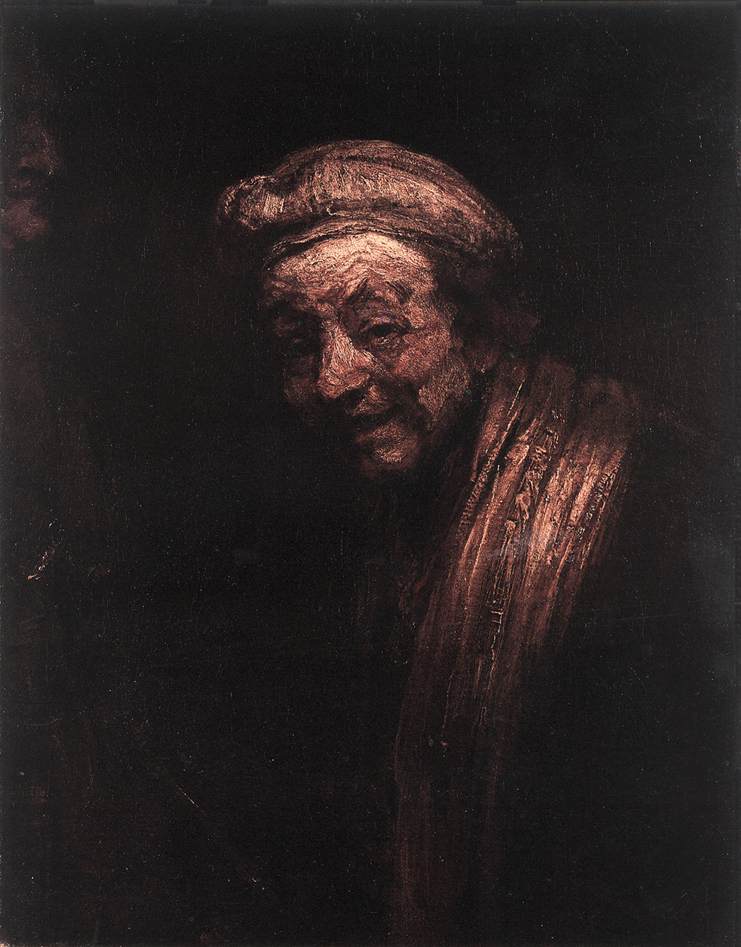
This his raises resistors and the laughter lust of Rembrandt, who provides comment on the ' self-portrait as ZEUXIS ' (left). He paints an ugly, smiling old man: himself. In a corner of the painting is still an old woman painted, but hardly visible. Rembrandt himself must be considered as the main topic. Zeuxis is a figure from antiquity, which laughed himself to death when he an painted in his old age an old woman: such an ugly old woman!!!
REMBRANDT is realistic enough to portray himself as old and is artist enough to that anyway in a nice way (and without laughing to death). He turns himself against currents in the art that wants only to show beautiful things by way of ' elevation ' of the people. He is a representant of the realistic DUTCH painting tradition. After Saskia's death, he develops the realistic style even further, often in religious paintings.
NIL seems strongly oriented on the (language) innovative currents in France, the Encyclopedists. The theatre work is more cheerful, more comedy, spectacle and technique. Between 1672 and 1677 is the Theatre closed due to the war with the French. Probably the Calvinist city fathers this a good thing. They are already annoyed at the pieces.
5. IN AMSTERDAM HIDDEN SCIENTISTS (Descartes: Kalverstraat, met opschrift: Westermarkt 6; Locke, Damstraat/Oude Hooghstraat, Westermarkt)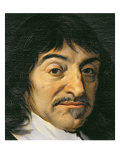
As was the case for the non-reformed believers to adapt to the line: ' there is freedom of religion, but you should not show with it ', so was also the rule for scholars with progressive ideas, which had too farfetched implications. A wide circle of people offered in general protection against actual persecution. In addition, Amsterdam did benefit from such free thinkers. If you're a bit calm, it was possible to find protection in Amsterdam.
Say where exactly in the Kalverstraat he lived, is unknown, probably in an old monastery, but (left), RENÉ DESCARTES (1596-1650) has lived here at least for a while. Later he lived some years on the Westermarkt 6. His ideas were very controversial. He had to be worn unobtrusively, but said: ' Hollanders are so busy with money, they don't take notice of me'. Descartes just as later Spinoza, from prudence, published a part of his work only until after his death. His publisher was Elsevier; translations into Dutch were issued by Jan Riewertsz, also the publisher of Spinoza.
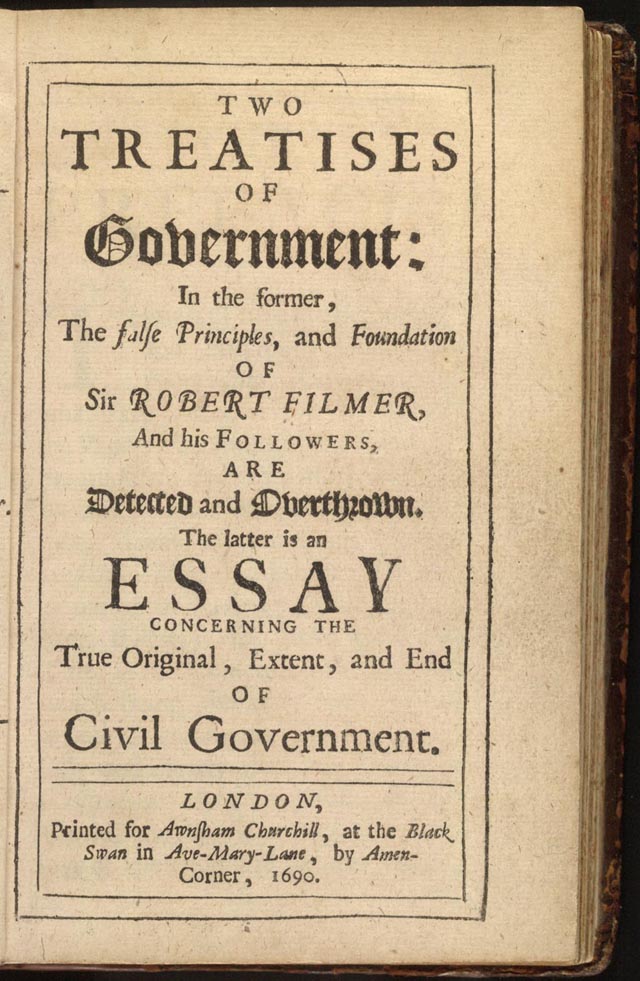 Other scholars have lived for a time in Amsterdam, among others (right) JOHN LOCKE (1632-1704) of 1683-1689 in the Damstraat. He writes than to two treatises on the State (right). Because he had to watch out for persecutors from England he took a pseudonym from caution: ' Doctor van der Linde '. It seems like a tribute to Hugo Grotius (1583-1645), who might have used the same pseudonym. Hugo Grotius-themselves was in 1618 as it simultaneously with of Oldenbarneveldt condemned but not like him beheaded, and walked after his well-known escape from the books kist openly around in Amsterdam . For example, he was present at the opening of the Athenaeum Illustre in 1632. Yet later, Hugo Grotius went to live in France.
Other scholars have lived for a time in Amsterdam, among others (right) JOHN LOCKE (1632-1704) of 1683-1689 in the Damstraat. He writes than to two treatises on the State (right). Because he had to watch out for persecutors from England he took a pseudonym from caution: ' Doctor van der Linde '. It seems like a tribute to Hugo Grotius (1583-1645), who might have used the same pseudonym. Hugo Grotius-themselves was in 1618 as it simultaneously with of Oldenbarneveldt condemned but not like him beheaded, and walked after his well-known escape from the books kist openly around in Amsterdam . For example, he was present at the opening of the Athenaeum Illustre in 1632. Yet later, Hugo Grotius went to live in France.
he freedom was not limited only by the Calvinist consistory, which put the Amsterdam vroedschap regularly under pressure. The last was tespecially from to directed to maintain the rest in the city. Further, the Corporation is also had to keep to agreements with the States of Holland. For John Locke would be the English secret police have formed the main threat.
In addition, the Catholic Church played a role. In 1600 was Giordano Bruno, philosopher, cosmologist, and Freethinker, by the Inquisition in Rome condemned to burn at the stake. Galileo Galilei, the famous physicist and astronomer, is sentenced to house arrest by the consistory, in 1633, the Inquisition. There were sometimes suspicions raised, that the Catholic Church through poisoning stripped itself from controversial members of her church . The the only Pope from the low countries, Adrianus IV (Adrian Boeyens, 1459-1523 Floris son), had just as Luther little with the indulgences-trade (1517) in the Catholic Church. He had surrounded himself in the Vatica with some kindred spirits from the low countries, including Jan van Scorel (149-1562). The last went back to Utrecht immediately after the Popes quick death, because he suspected that the Pope was poisoned and also feared for his own life. Descartes was the last year fled to Sweden, where he was protected by the progressive Christina of Sweden. That the Catholic Descartes ound death by poisoning by a priest through a hosting is still recently suggested by Theodor Ebert.
59. PUBLISHERS AND BOOKSHOPS (Warmoesstraat 140, Van Beyerlandt)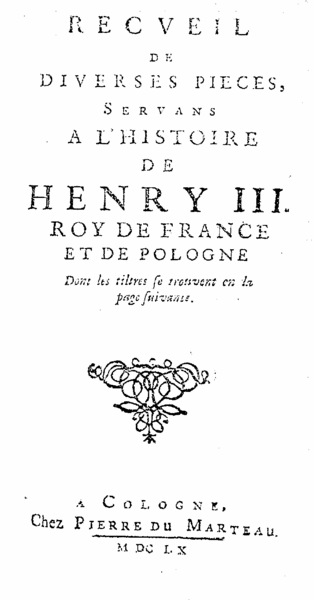
Amsterdam has become a major publishers-city (second besides Londom). There is also therefore that in many places is aken note of new insights. This applies to the publishers, but also for their patrons. Some rich merchants spend their wealth to doing book publishing and protecting writers (Louis and Laurens de Geer protects including Descartes ànd Comenius; Jarig Jelles Spinoza; Van Beyerlandt Jacob Böhme). Also among the magistrate are patrons (Johannes Hudde and Nicolaas Witsen). Book publishers have often played a role in the protection of innovative spirits, such as for example the Gouda printer Tournay. From 1660 Jean Elzevir starts editing under a PUBLISHERS PSEUDONYM (left): PIERRE DE MARTEAU to circumvent the censorship.
Constantijn Huygens protects Descartes and advises him a publisher (Blaeu, Amsterdam, Alkmaar, 1596-1673). Moreover, this does not always say that the patrons totally agree with the author. So Huygens also takes away from Descartes ' ideas. Another protegee of the Geers, Comenius, also doesnot agree on all points with Descartes.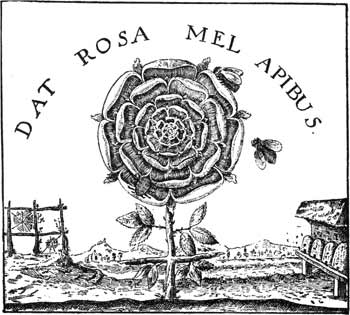
In Amsterdam are also published so-called hermetic books, books of wise men from all over the world in the line of the Egyptian 'wiseman' Hermes Trismegistus. Including a writings of Trismegistus itself (issued by Nicolaas van Ravesteyn). Some works from the ' Philosophica Hermetica' were published by Johannes Janssonius. Another publisher was Christopher Cunradus.
Amsterdam plays this way an important role in the exchange between intellectual networks in Central and West-Europe.
One of the many examples of international contact is that between the Sileziër Von Franckenberg and the English physician Robert FLUDD (author of SUMMUM BONUM, see cover right).
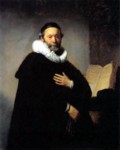 Where the free thought threatened to be suppressed, arose a counter-movement. Moreover, not always with success. Mr. John Uytenbogardus (Singel 324) (see right, Rembrandt's JOHANNES UYTENBOGAERT) takes on for painter and rosicrucian Torrentius and informs Hugo Grotius. Nevertheless, he is sentenced (Uytenbogardus is a relative (cousin) of Johannes Wttenbogaert (1557-1644), which had a place on the ' driver ' DRECKWAGEN ARMINIAN and is considered as the successor of Arminius).
Where the free thought threatened to be suppressed, arose a counter-movement. Moreover, not always with success. Mr. John Uytenbogardus (Singel 324) (see right, Rembrandt's JOHANNES UYTENBOGAERT) takes on for painter and rosicrucian Torrentius and informs Hugo Grotius. Nevertheless, he is sentenced (Uytenbogardus is a relative (cousin) of Johannes Wttenbogaert (1557-1644), which had a place on the ' driver ' DRECKWAGEN ARMINIAN and is considered as the successor of Arminius).
3. CITY HALL ON THE DAM AFTER 1650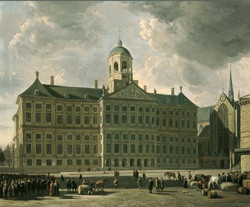 (left) DAM WITH CITY HALL (NOW PALACE) OF J. VAN CAMPEN AND NIEUWE KERK (Berckheyde, 1673)
(left) DAM WITH CITY HALL (NOW PALACE) OF J. VAN CAMPEN AND NIEUWE KERK (Berckheyde, 1673)
In 1650 (the war against the Spaniards ended in 1648) reached richness in Amsterdam a peak. The city has grown from 30,000 inhabitants in 1580 to 210.00 in 1650. There is then rapidly much built and of high quality. Much is left untill now. Before the Town Hall was small compared to the Church, the new City Hall which was built at that time, was great and high. Caution: larger and higher than the Church! There was waked for that the church tower not jutted above the City Hall. Against Van Campen plan for a high tower for the Church sparked resistance and the tower came not there. This fuss ideas on the relationship of Church and State, which is also found in Pieter de la Court's ' Interest van Holland ' (1662). Spinoza also finds: the Church must ultimately add to the State.
There was an exuberant atmosphere of Amsterdam. The town hall would be the eighth wonder of the world.
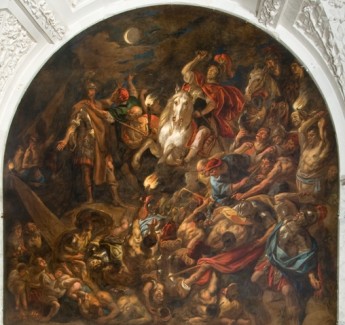 Within the Dutch master-painters such as the Flemish Jacob JORDAENS (1593-1678) (right) could get started. The specified theme was: the ' REVOLT AGAINST the SPANIARDS ', what was imagined by the Batavians under CLAUDIUS CIVILIS rebelling against the Roman occupiers. France had supported Amsterdam, so it seemed. A French baroque ornate style, which partly by Flemish painters like Rubens, was imported, to honor the heroic rebels, was what the vroedschap liked.
Within the Dutch master-painters such as the Flemish Jacob JORDAENS (1593-1678) (right) could get started. The specified theme was: the ' REVOLT AGAINST the SPANIARDS ', what was imagined by the Batavians under CLAUDIUS CIVILIS rebelling against the Roman occupiers. France had supported Amsterdam, so it seemed. A French baroque ornate style, which partly by Flemish painters like Rubens, was imported, to honor the heroic rebels, was what the vroedschap liked.
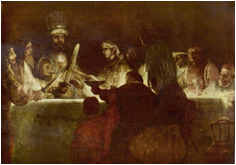
Also REMBRANDT (left) got a command for this. Only ... he painted Claudius as not as combative hero but as old man. In a staging, reminiscent of the Last Supper. He shows his strength in the forged unity and by threatening with the sword, but not by a fighting spirit. The principals did not like it and his work disappeared to the cellars. The other painters had did the heroiek of the ' Rebellion ' stressed.
Patriotic virtues, those of so-called Batavian origin, were in the spirit of Erasmus, Dirck Volckertszoon Coornhert and Hugo de Groot, sense of freedom, frankness, simplicity, frugality, courage, cleverness, peace-loving and sincere piety. The Batavians were a nation that not only aspired freedom but also cultivated equality. A people that does not have cherished the authority (vertical) central, but the family (horizontal) as the basis of society (Frijhoff, Spies, 1650). Maybe wanted Rembrandt to honor the spirit of this people in his painting.
POLITICAL DEVELOPMENTS UNTIL 1650
In 1648 through the peace of Münster he 80-year-old war with Spain and the thirty years war (1618-1648) came to end.
Reason for the 30-year-old war was a revolt in Bohemia (Czech Republic). Sweden and France were opponents of the Emperor of the Holy Roman Emperor Ferdinand II. The Republic with stadtholder Frederick Hendrik supported the Palts (capital Heidelberg), Bohemia and the in 1608 founded Protestants Union of Protestant princes and imperial cities. 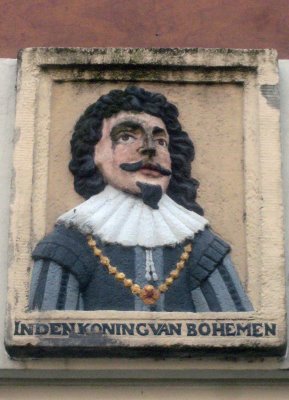
Grandson of William of Orange, the Protestant Frederick V of Bohemia van de Palts (1596-1632) (right, façade stone Egelantiersgracht 153/159), married the English Elizabeth Stuart (1596-1662), son of Countess Louise Juliana Princess of Orange (1576-1644) and grandson of William of Orange, played a role in the European Reformed case. His portrait also appears on the cover of Hobbes ' Leviathan. He comes to the Hague along with an extended family and court. In Amsterdam the guns producer Louis de Geer is closely connected with this Reformed movement.
There is a great relationship between the Dutch Court, the family van der Palts (also related to William of Orange), the English Court, particularly the Stuarts and the struggle for the Protestant cause. Also the Secretary of the stadtholders Frederick Hendrik, William II and William III and their diplomat, Constantijn Huygens, feel connected to the struggle for the Protestant cause. These courts are often important meetingpoints for artists, scientists and diplomats, who in this way mutually know each other.
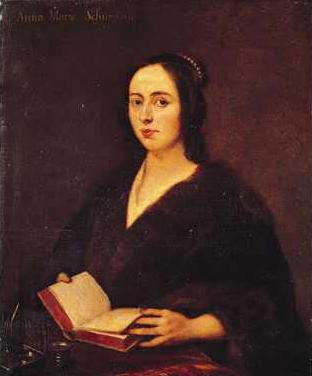 Constantijn Huygens meets on the English court Cornelis Drebbel and Frances Bacon. Also with the women coming to the courts they have regularly an intellectual exchange.Daughter of Frederik V van der Palts and Elisabeth Stuart, Elisabeth van der Palts (1618-1680) (right-hand column), corresponds to Descartes and maintains contact with the high-intelligent and developed ANNA MARIA VAN SCHURMAN (1607-1678) (self portrait, left). Descartes goes to Catharina of Sweden and maintains contact with Elisabeth van der Palts. The women play in plays which are made to show them honor, for example Maria Stuart.
Constantijn Huygens meets on the English court Cornelis Drebbel and Frances Bacon. Also with the women coming to the courts they have regularly an intellectual exchange.Daughter of Frederik V van der Palts and Elisabeth Stuart, Elisabeth van der Palts (1618-1680) (right-hand column), corresponds to Descartes and maintains contact with the high-intelligent and developed ANNA MARIA VAN SCHURMAN (1607-1678) (self portrait, left). Descartes goes to Catharina of Sweden and maintains contact with Elisabeth van der Palts. The women play in plays which are made to show them honor, for example Maria Stuart.
The early death of Willem II (1650) brought the Republican party to power with Johan de Witt as Grand Pensionary. His appointment, however, could only be done with the express consent of Amsterdam, then led by Mayor Cornelis de Graeff, the most successful Amsterdam mayor from the Golden Age, of whom the Witt was a cousin. The exemplary cooperation between the two politicians was an important factor in the success of the revival of the economy after Witts politics and the first Anglo-Dutch war. De Witt recognized fully the power of his uncle, and did his best to follow the Amsterdam wishes. He married the Amsterdamse Wendela Bicker (1635-1668), also from the influential Amsterdam genus Bicker; her father was Johan Bicker (1691-1653) and her mother Agneta de Graeff (1603-1656).
POLITICAL DEVELOPMENTS FROM 1650
Now there was peace with the Spaniards from1648 following the successful rebellion, new enemies came : first the English. The three English wars (1652-1654), (1665-1667) and (1672-1674) were especially focused on sea and supremacy in the colonies. The wars affect the success in the Republic. For example, Spinoza and Rembrandt camp in 1656 with financial difficulties. In 1663-1664, Amsterdam was hit by a epidemic plague. For Amsterdam and the Republic the Northern trade is the most important.
The war between Sweden and Denmark is likely to have had consequences for the Dutch interests of reasonable tolls. Johan de Witt in principle carries a diplomatic struggle based on defensive alliances, a policy in line with Hugo Grotius based on not to attack unless the country itself is attacked.
Between 1667 and 1696 one of the richest men of Europe, Cosimo III de Medici (1642-1723), Grand Duke of Tuscany, visits the Republic. He met, among others, Constantijn Huygens, Johannes van Neercassel, Heinsius, Vossius, Graevius, Swammerdam and several art collectors. Also he visits the Amsterdam Schouwburg, where Medea of Jan Vos is played. On his English travel he meets Oldenburg, Boyle and Newton. His son is likely to be raised by the Danish anatomist Niels Stensen. Later it will have contact with the son-in-law of Franciscus van den Enden. He gives Theodor Kerckring and Maria Clara financial support
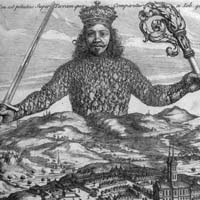
n 1667 is Hobbes ' LEVIATHAN (left), the matter, forme and power of a common wealth and civil ecclestiall ' (1651) in Dutch comes available, translated by Abraham van Berckel (1639-1686) and published by Elzevir; in 1668 in Latin.
Although work on the relationship of Church, State and power in many ways looks like Spinoza's TPT is Hobbes ' conclusion different: according to him is for a State with internal peace and a good defence against external enemies needs one central monarch, whose authority is absolute. A religious ' locus of power ' in addition to the worldly power he finds undesirable.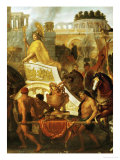
In a theological State and power go together on theocracy. but also when the separation between ecclesiastical and secular power is greater, finds the ruler support in a divine assent to his reign. Louis XIV also creates a divine image in order to support his power. He hereby no longer meets at a Christian support, but is similar to a classic hero, ALEXANDER the great (right), and with a naturalistic Centre: the Sun.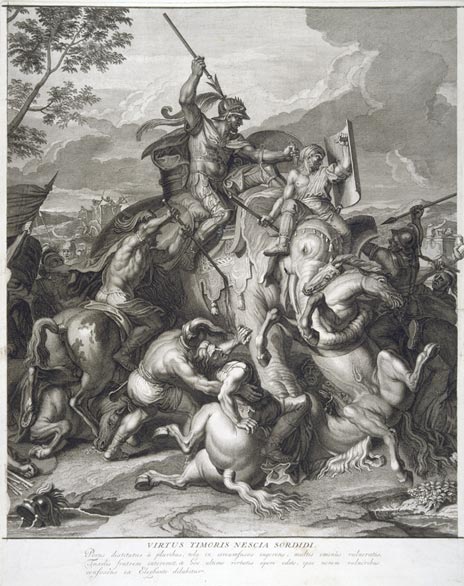
From 1667 Louis XIV Sun King is trying to expand his territory, first in the Spanish Netherlands, gradually towards the Flemish provinces.
Alexander the great was the example that Louis XIV made the people keep in mind. Lodewijk's favourite painter Charles le Brun, who is portrayed,in the Louvre next to the ' Sun King ' Louis XIV, glorified the slain in the fight for a monarch (left) on the ' ALEXANDER paintings (1660-1665) ', which he made in command of Louis XIV. By show these paintings, the people could compare him with Alexander ' the great '.
In 1667, an ' Eternal Edict ' (advocated in Pierre de la Court's ' The interest of Holland ' from 1662) was drawn up by Gaspar Fagel (1634-1688), Gillis Valckenier and (under reservations, tragically seen subsequent developments) Johan de Witt, which would have abolished the stadtholdership forever.
The Chairman of a Commission overseeing the education of William III (with, among others, Johann de Witt and Gaspar Fagel as members), the Amsterdam mayor 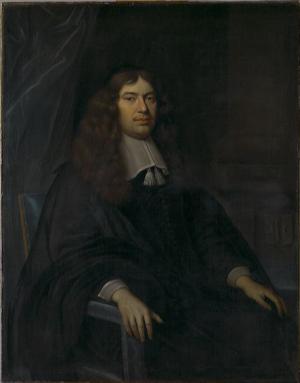 Gillis VALCKENIER (1623-1680) (left), puts however, already in 1668-1669 the door open for the Prince and makes a switch from State-minded to a Prince- inclined Board possible. Given the real threat of war of the French not incomprehensible. This calls for more centralization of governance.
Gillis VALCKENIER (1623-1680) (left), puts however, already in 1668-1669 the door open for the Prince and makes a switch from State-minded to a Prince- inclined Board possible. Given the real threat of war of the French not incomprehensible. This calls for more centralization of governance.
Coenraad van Beuningen (1622-1693) is the Witt's Ambassador in Sweden. He was formerly Secretary of Hugo Grotius. Hegets more and more trouble with the offensive action of Sweden for which he warns de Witt . From 1668 the French, the former allies against the Spaniards, begin to enter the North. Also in France, Van Beuningen becomes ambassador. Johan de Witt likes through diplomatic agreements to come to a Covenant with Louis XIV with the southern Netherlands under common management. He assumes that the English and the French will remain separate, but these constitute a Covenant. Van Beuningen warns the Witt for the expansion strive of Louis XVI.
In 1670 the (secret) Treaty of Dover (also called "Treatise of Dover ') was made between Charles II of England and Louis XIV of France. Charles promised to convert to Catholicism himself and England here and to leave the Triple Alliance, the Alliance with Sweden and the Republic of the Seven United Netherlands. England then would be France's ally in its war against the Dutch Republic. Louis , for his part, promised Charles on adequate financial resources to be less dependent of the English Parliament, and military support in the form of an army of 6000 men, should it come to an internal resistance. England became involved by this Treaty in the French-Dutch war and declared on 28 March 1672 war on the Dutch Republic.
Early 1672 the French (with in the wake the Catholic faith) come in the Netherlands and occupy Utrecht among others. The beginning of the Franco-Dutch war, which ends in 1679. 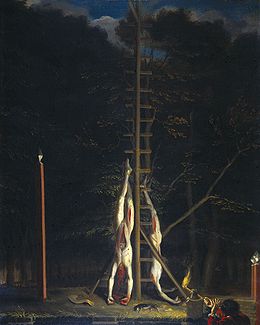 In 1672 (the Disaster year) ' the country was helpless, the Regents distraught andpeople irrational . In the Hague half a year after the start of the invasion the brothers DE WITT were MURDERED (right) and exhibited. It is likely that the 22-year-old William III was aware in advance that the de Witten would be put outside game. Possible the Rotterdam Johan Kievit and Cornelis Tromp played a role.
In 1672 (the Disaster year) ' the country was helpless, the Regents distraught andpeople irrational . In the Hague half a year after the start of the invasion the brothers DE WITT were MURDERED (right) and exhibited. It is likely that the 22-year-old William III was aware in advance that the de Witten would be put outside game. Possible the Rotterdam Johan Kievit and Cornelis Tromp played a role.
Change the form of Government: William III (1650-1702), stadtholder (but a moderate form). The ' Eternal Edict ' terminated in 1672 because it would be incompatible with the post of Captain-General and Admiral-General. Fagel becomes William III's Advise Pensionary. The fierce anti-orangist Pierre de la Court leaves in 1672 the country.
In 1672, Stadholder William III on the advice of Council , Valckenier put sixteen members from the Amsterdam Council including Henrick Hooft, Pieter de Graeff and Andries & Lambert Reynst. Coenraad VAN BEUNINGEN (1625-1672) (left), who has been attracted to Spinoza and the collegiants Rijnsburgse felt longer, Nicolaas Witsen (1641-1717), Johannes Hudde and other family members came in their place: supporters of Spinoza's philosophy.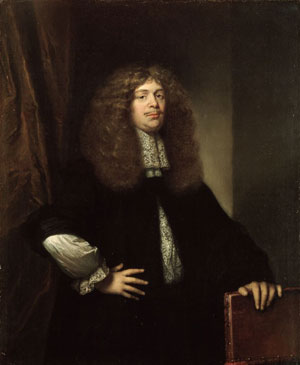
Holland in 1672, would also have been captured if not rushedly a water line would be installed. Utrecht feels still a century these recoil and also in the rest of the Republic is done with the prosperity.
On 19 February 1674 withdrawed England itself, for the sake of domestic political issues, from the fight. The French knew to win the battle of Cassel, without English support. Later England finally pulled back on his promises and supported the Dutch again in their fight against France. Van Beuningen, than in the vroedschap of Amsterdam, trying to follow a policy of consultation with Louis XIV in 1675 .
The historical assessment of the role of William III is, that he against the expectation in a targeted rate has followed on the interests of the low countries and has played an important diplomatic role in the European opposition to the French King Louis XIV. Both the Netherlands and France are financially exhausted. Ultimately, England in the 18th century is the smiling third.
After the signing of the peace with France in 1679 in Amsterdam and the Republic appears to have emerged a more Frenchdirected culture: more than formerly focused on grandeur. When the more and more getting Catholic Louis XIV in 1685 ends the Edict of Nantes of 1598, which had given the Huguenots rights of practising their faith and have garrison force in some cities, many Huguenots flight to the Republic. Christiaan Huygens, which in France is to make a contribution to establishing a French ' Royal Society ' and until then had drawn up neutral, goes back to neutral Holland
47. PEDAGOGY AND FAMILY LIFE (Keizersgracht 123: Comenius; Gelderse kade 16: Roemer Visscher)
According to Schama the Dutch at the time of the Republic were very attached to family life. And this looked particularly in the eyes of foreigners: the children were scoundrels and were more than in other countries hugged.
Murmellius (1480-1517) had written' Kinderpap ', with an emphasis in the tutorial on ' many admonitions ' and little on penalties. It was quite common for schools to save and humiliate poor-learning pupils. According to Murmellius another teaching method was possible: who could promote the motivation of the learner knew that cruel punishment is not necessary. Murmellius himself had had lessons of Alexander Hegius von HEEK in Deventer (1433-1498), who also had followed Erasmus classes. Murmellius was rector of the Latin school in Alkmaar, where in that time Jan van Scorel (1495-1561) and Amsterdam Alardus (1495-1544) followed lessons.
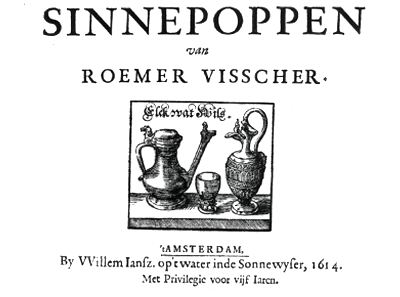 Roemer Visscher had written 'Sinnepoppen' (1614), illustrated by the well-known engraver Claes Jansz Visscher (no family). The titlepage seems to refer to a Rosicrucian painting of Torrentius from 1614.
Roemer Visscher had written 'Sinnepoppen' (1614), illustrated by the well-known engraver Claes Jansz Visscher (no family). The titlepage seems to refer to a Rosicrucian painting of Torrentius from 1614.
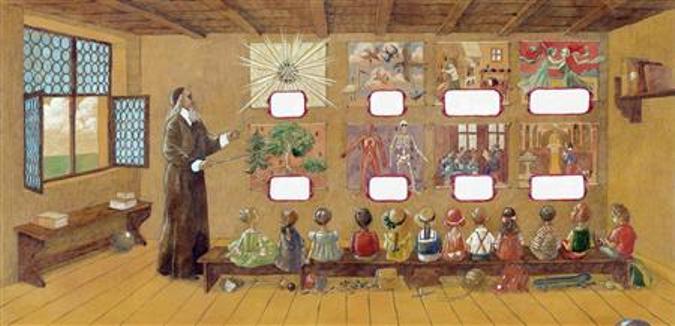
Left a class of pedagogue Jan Amos COMENIUS, who is often in the Netherlands. He stresses the importance of informative education. It is also to see that he learns about nature: he points to the stars, plants, etc. Comenius also writes books for mothers about how, where and at what age their children can learn the most.


